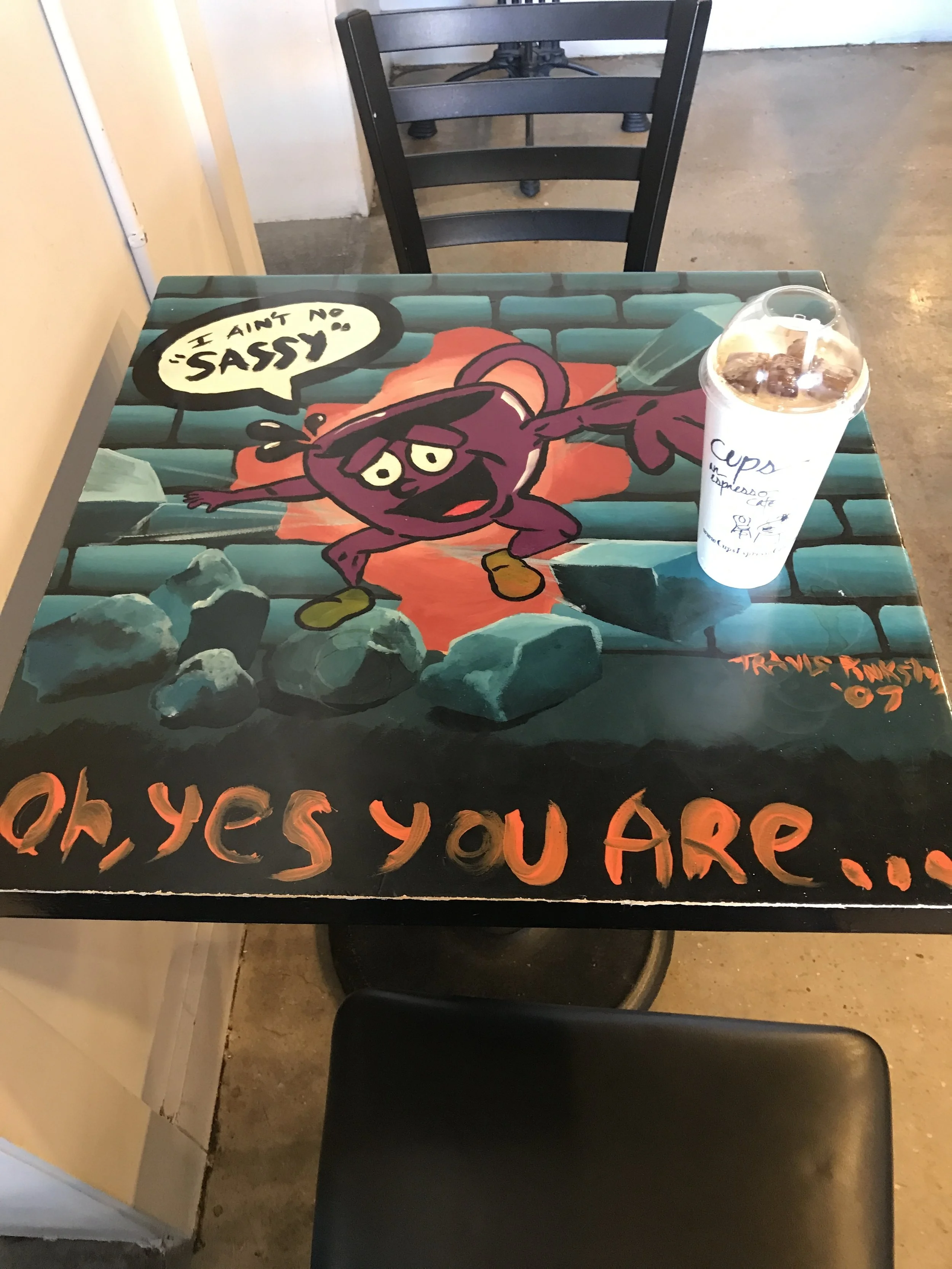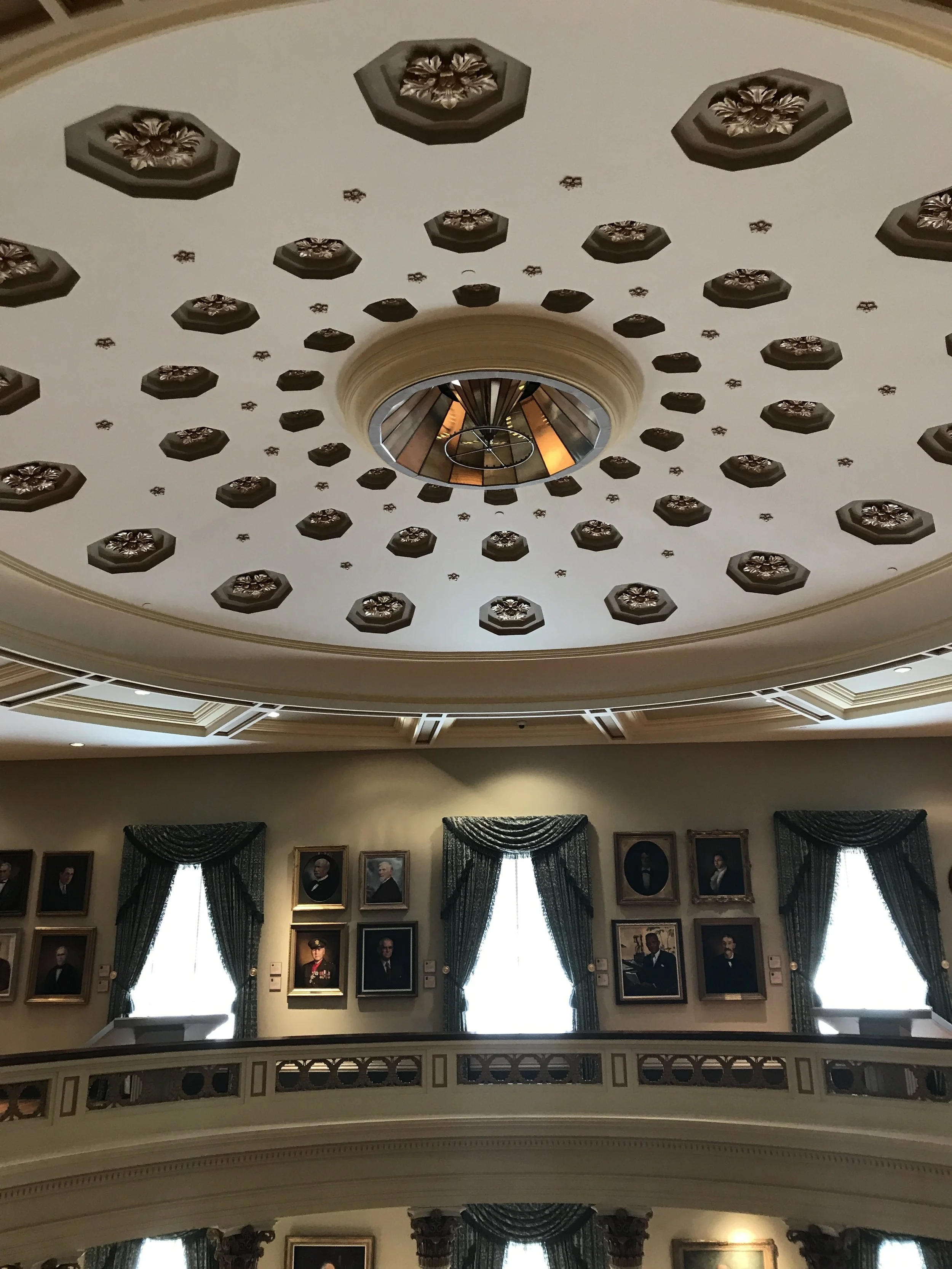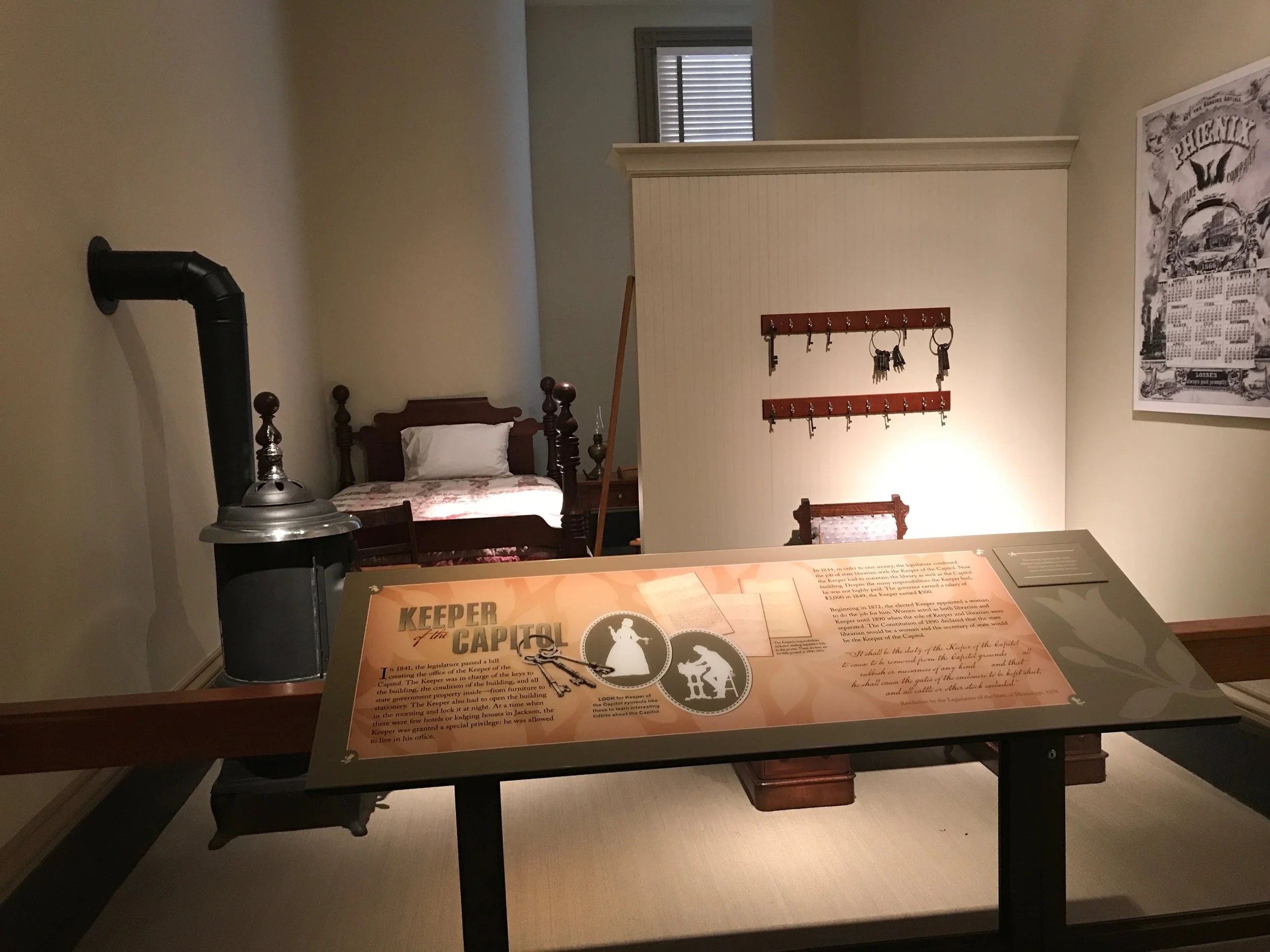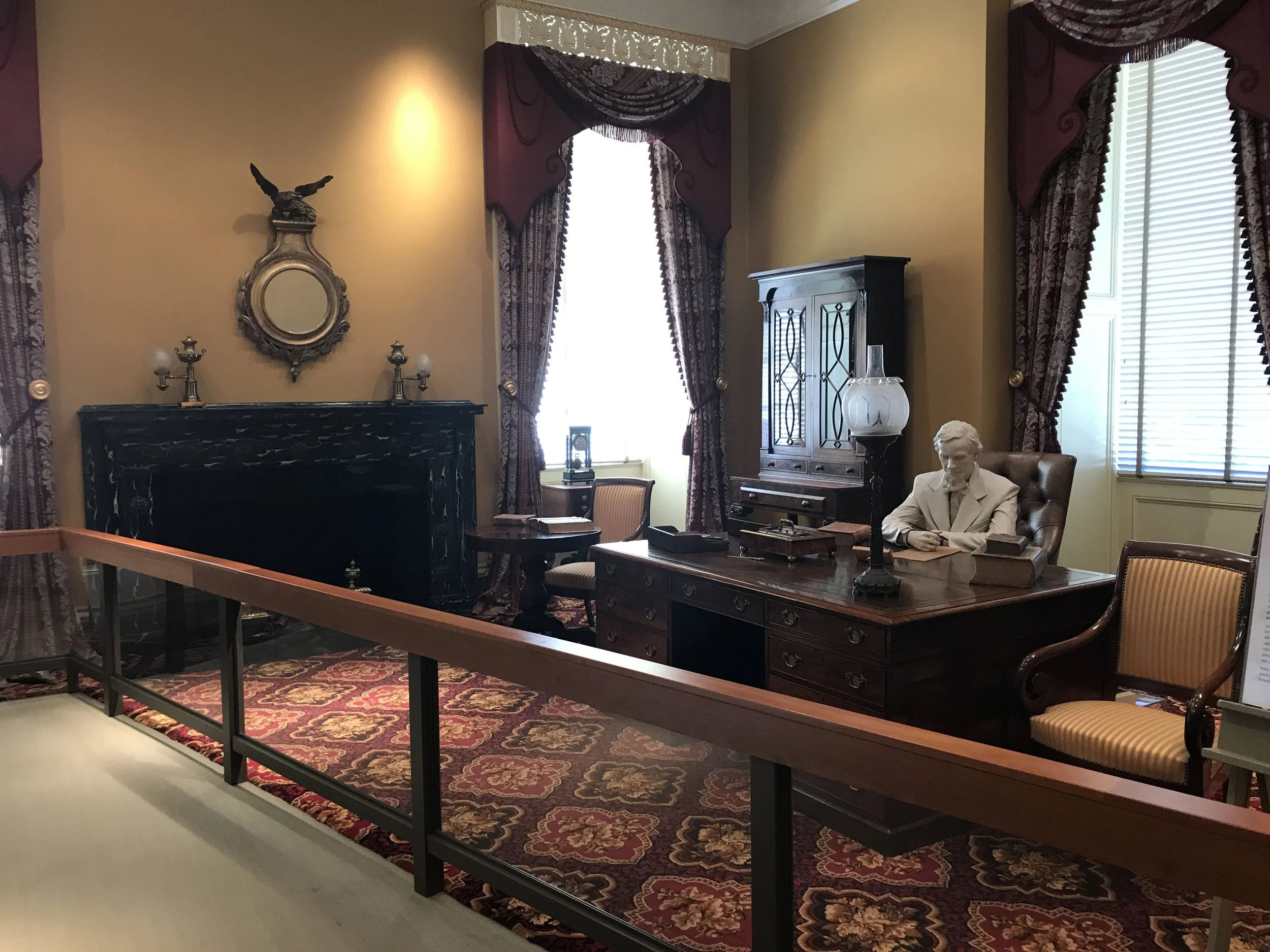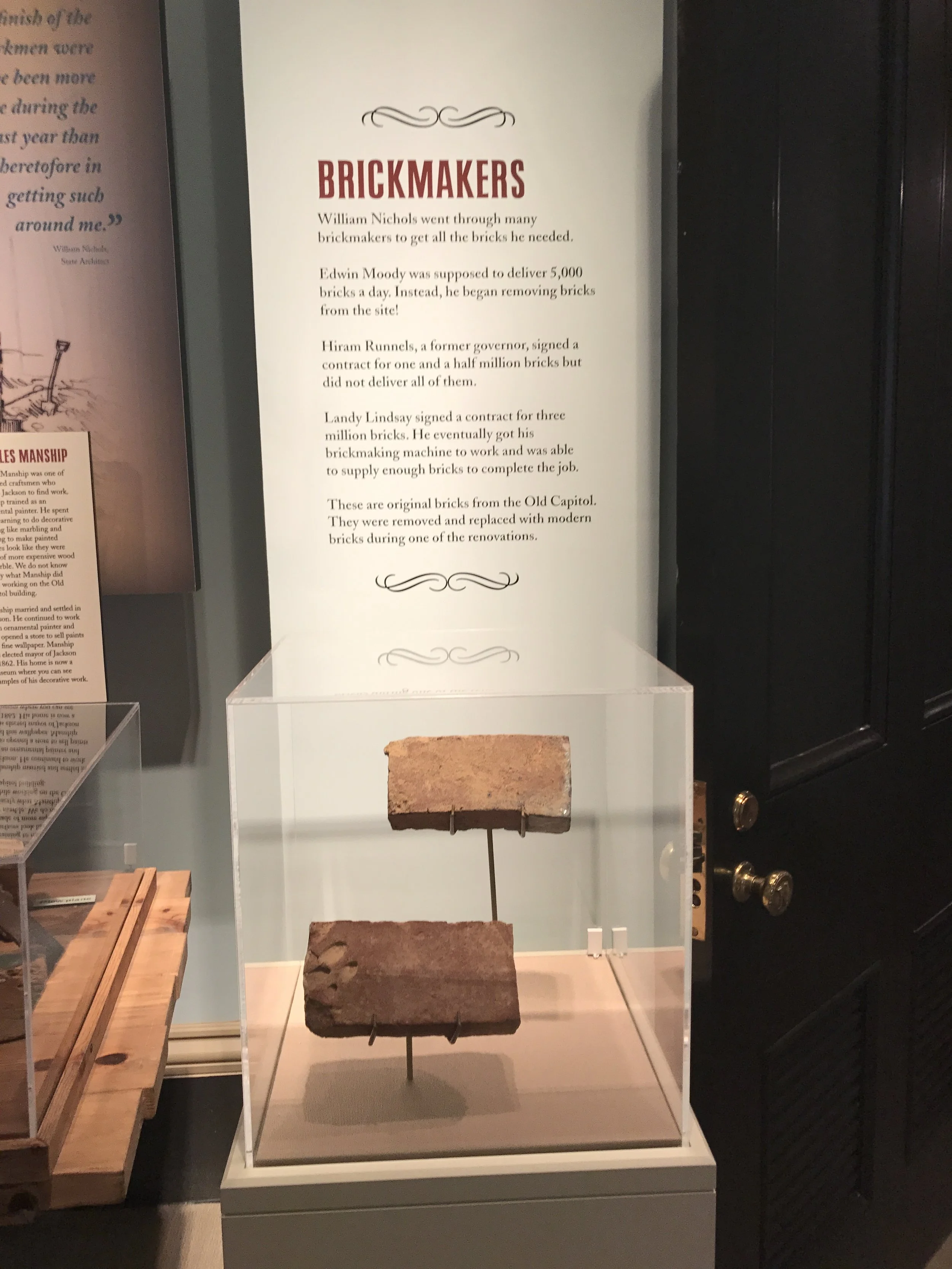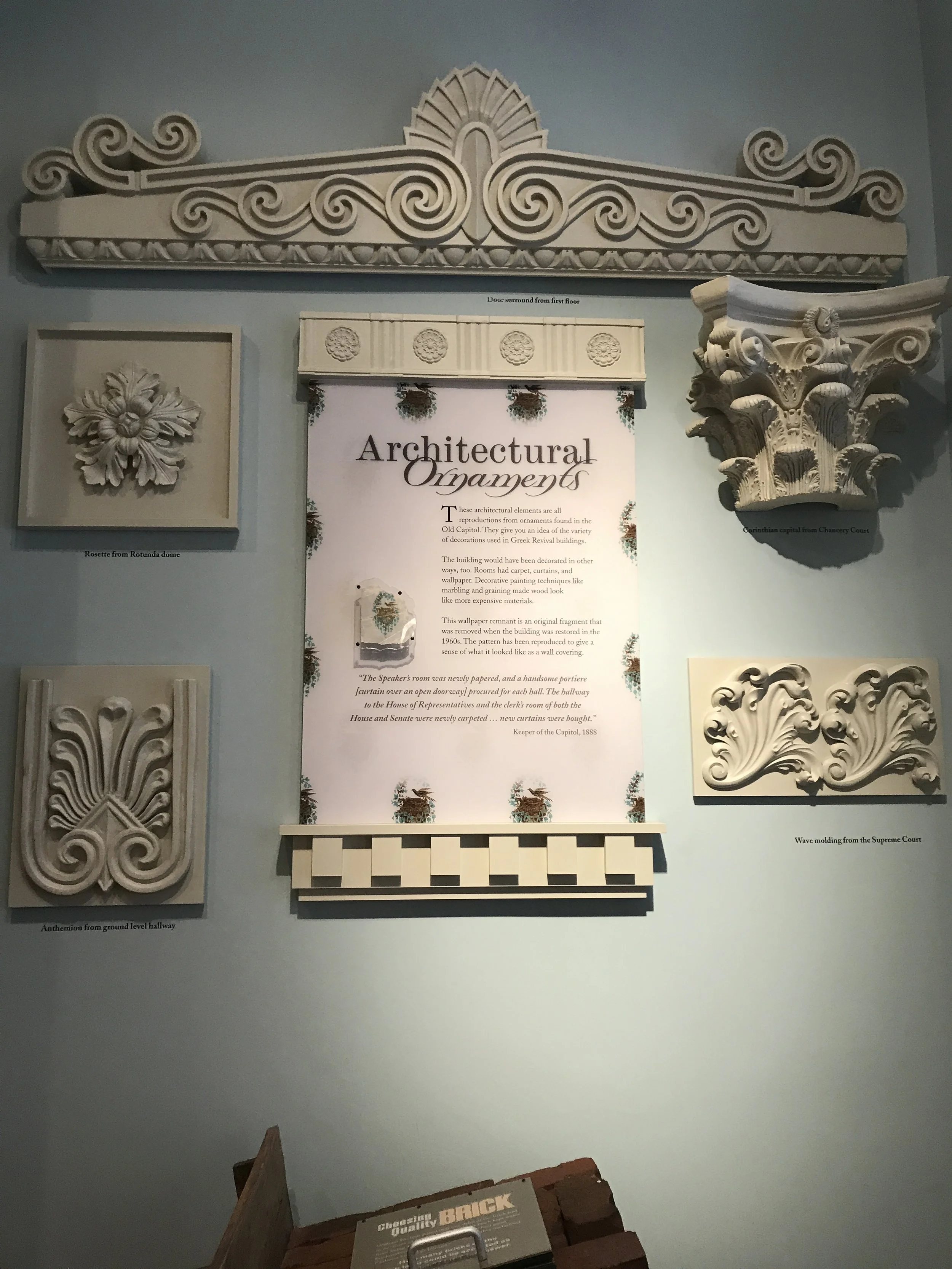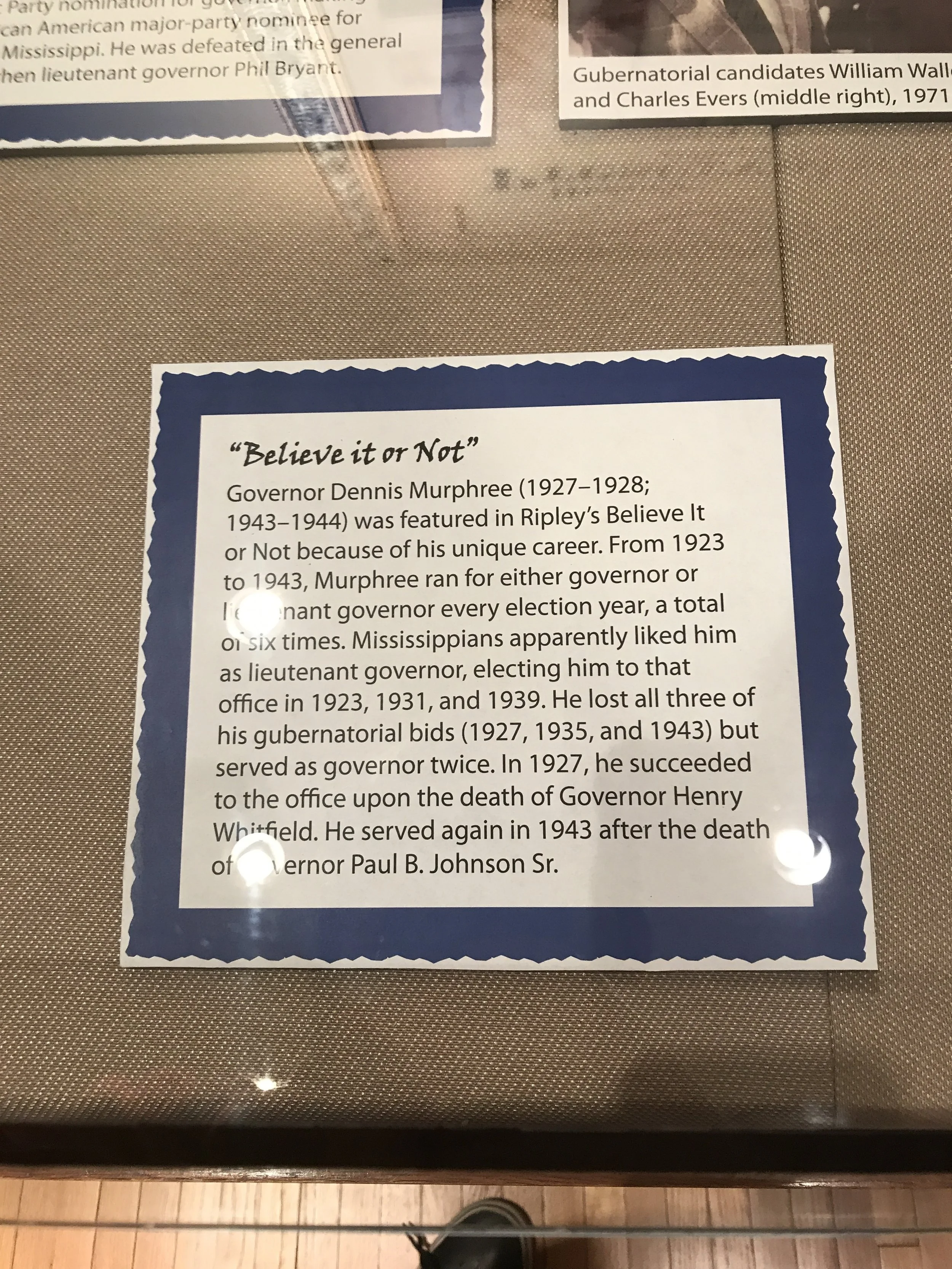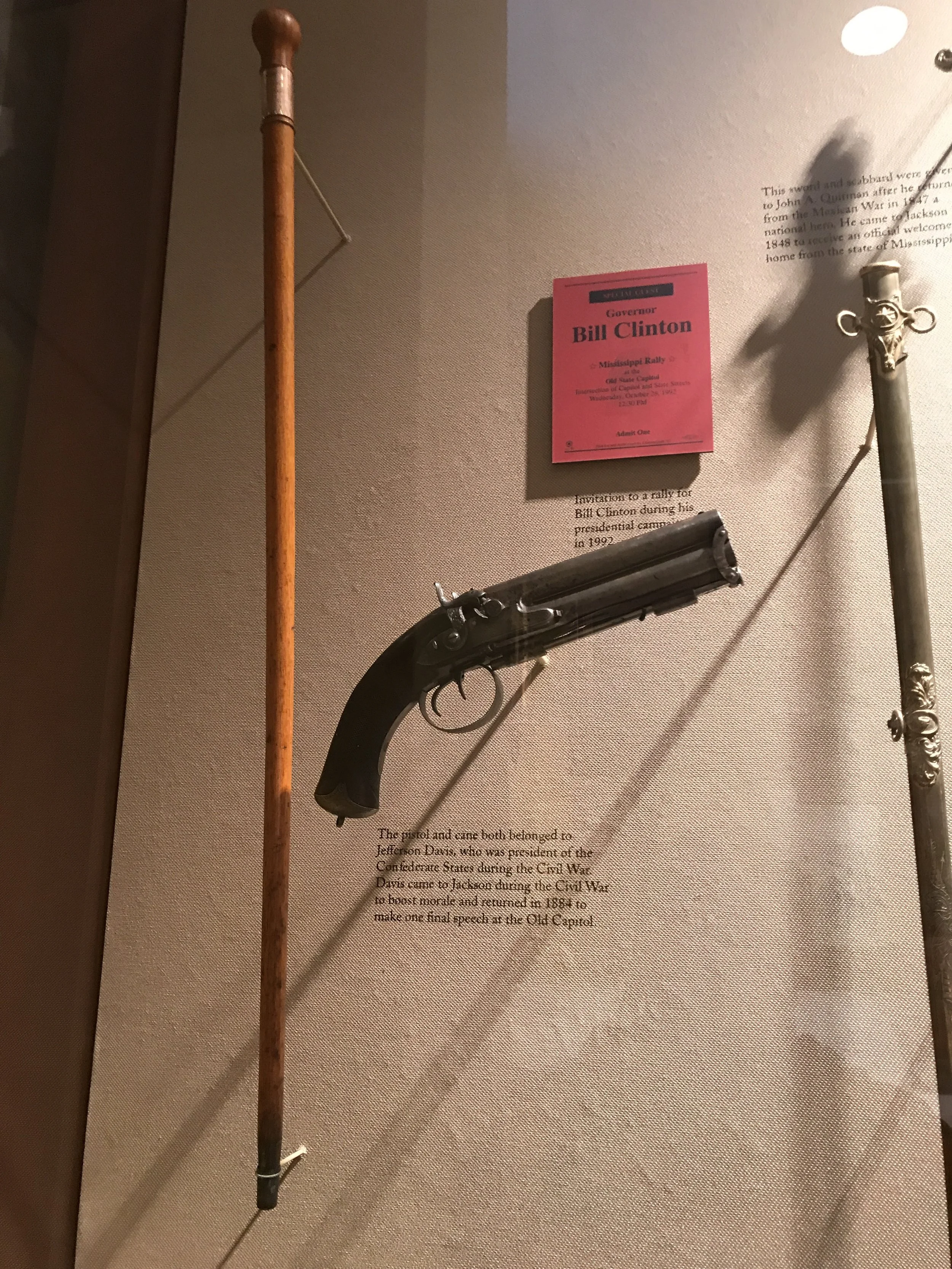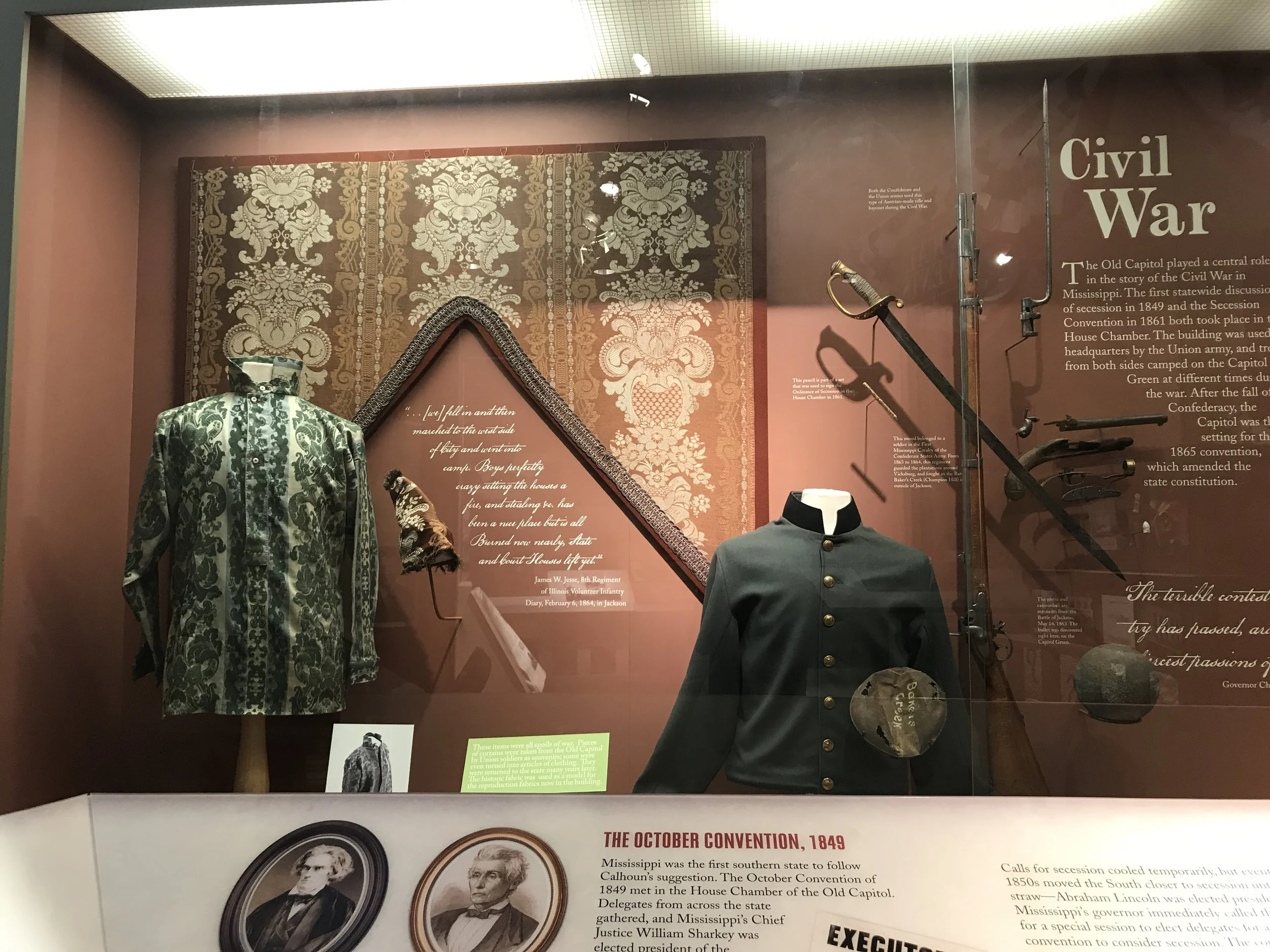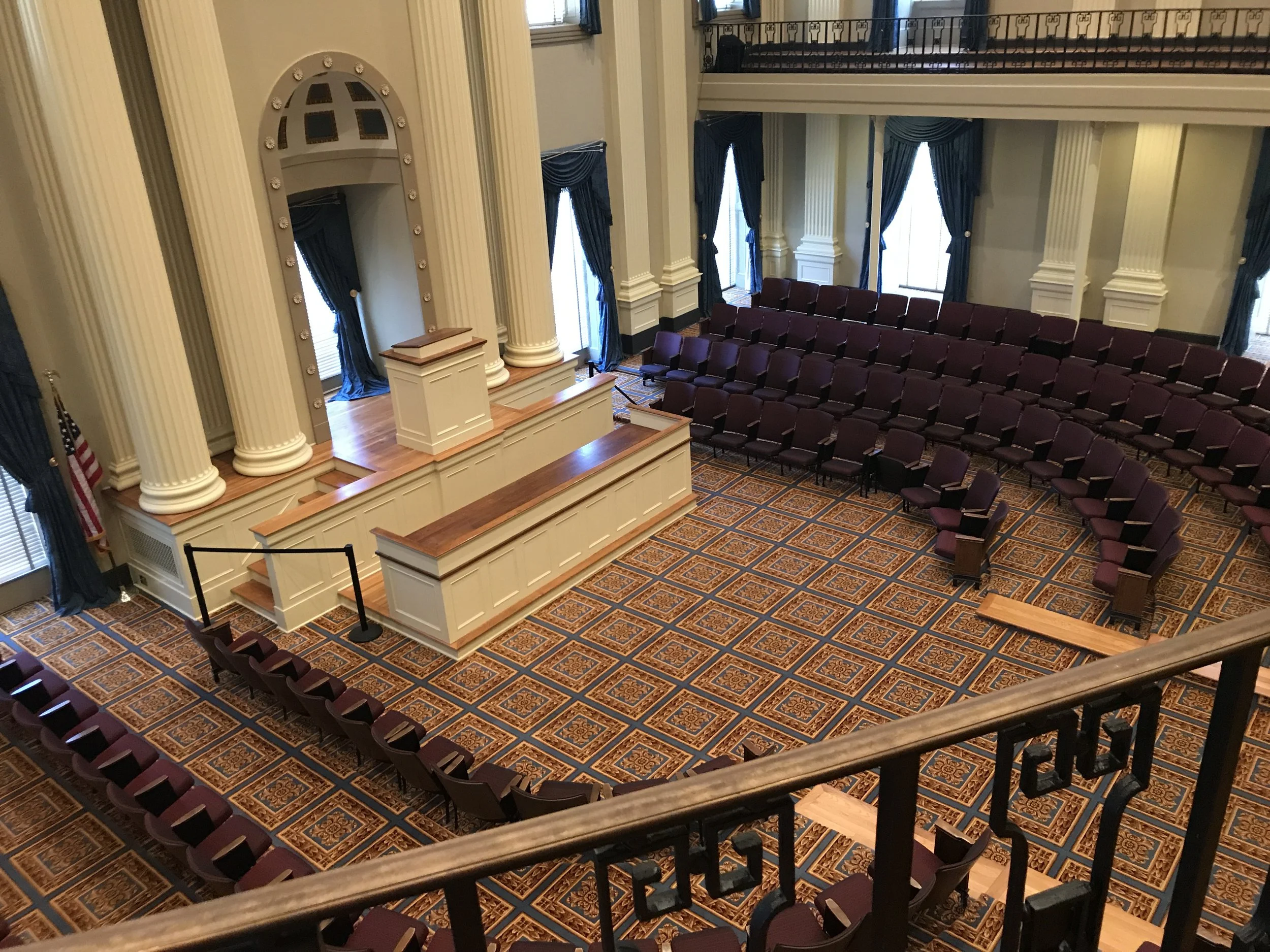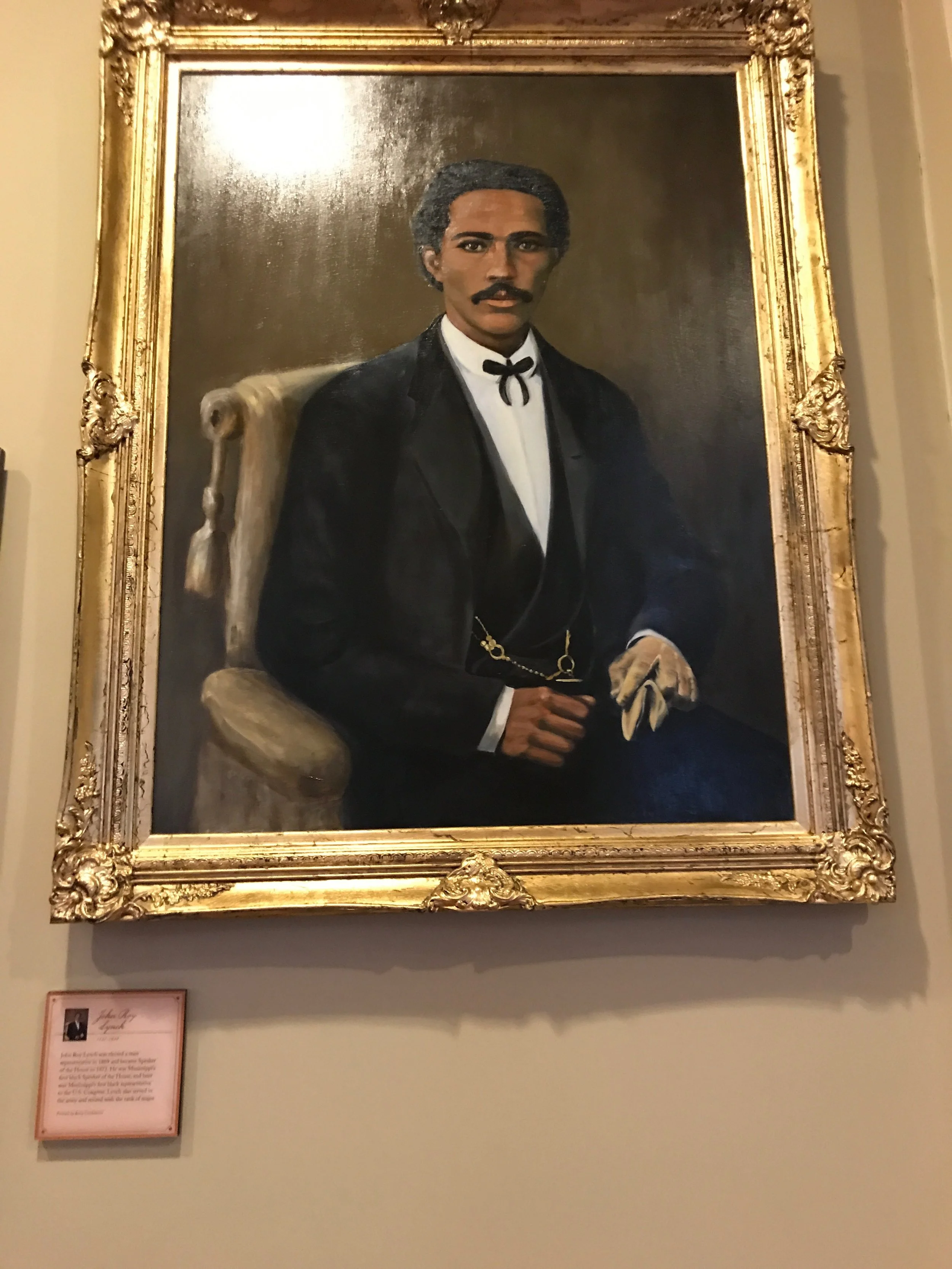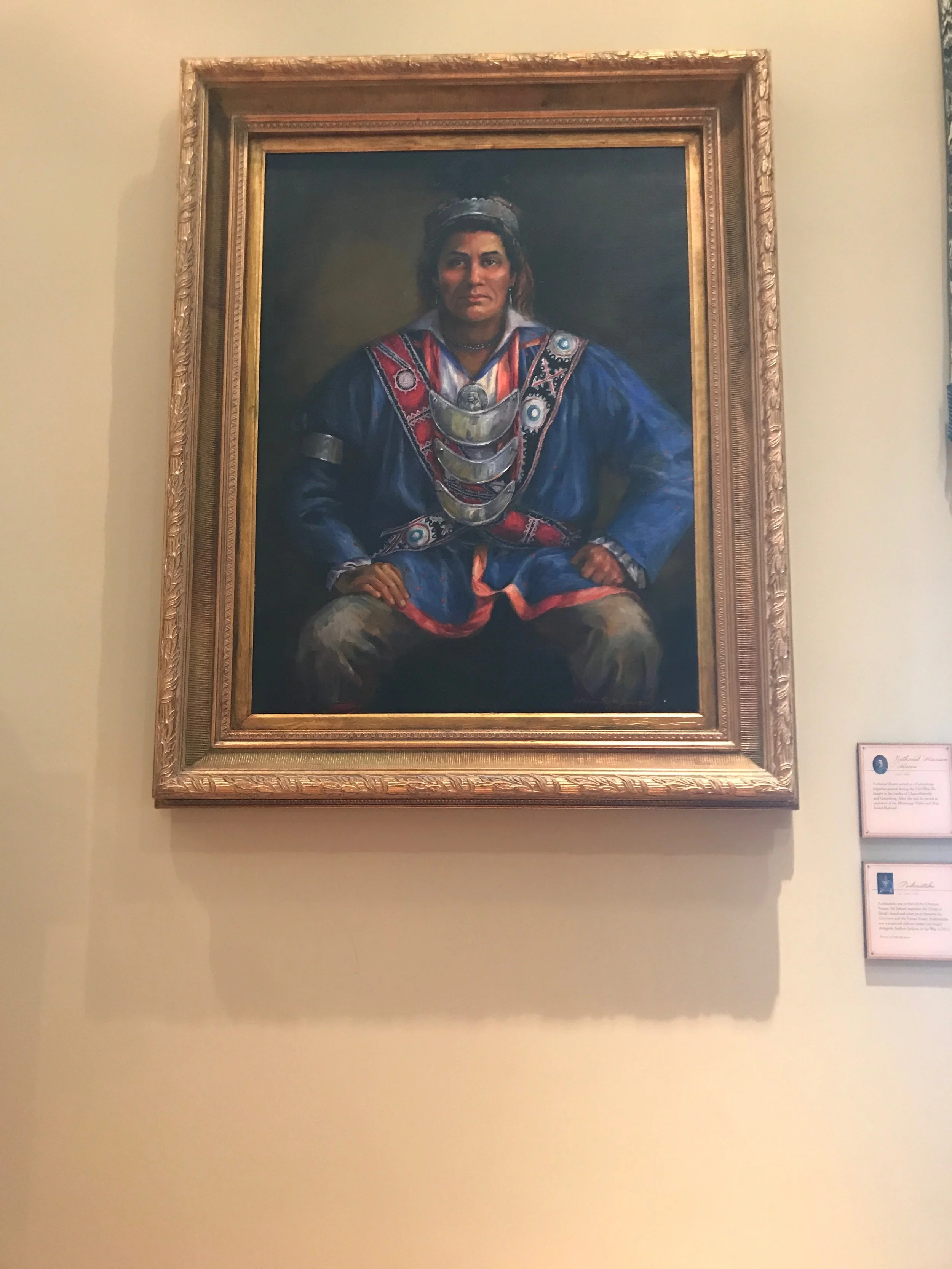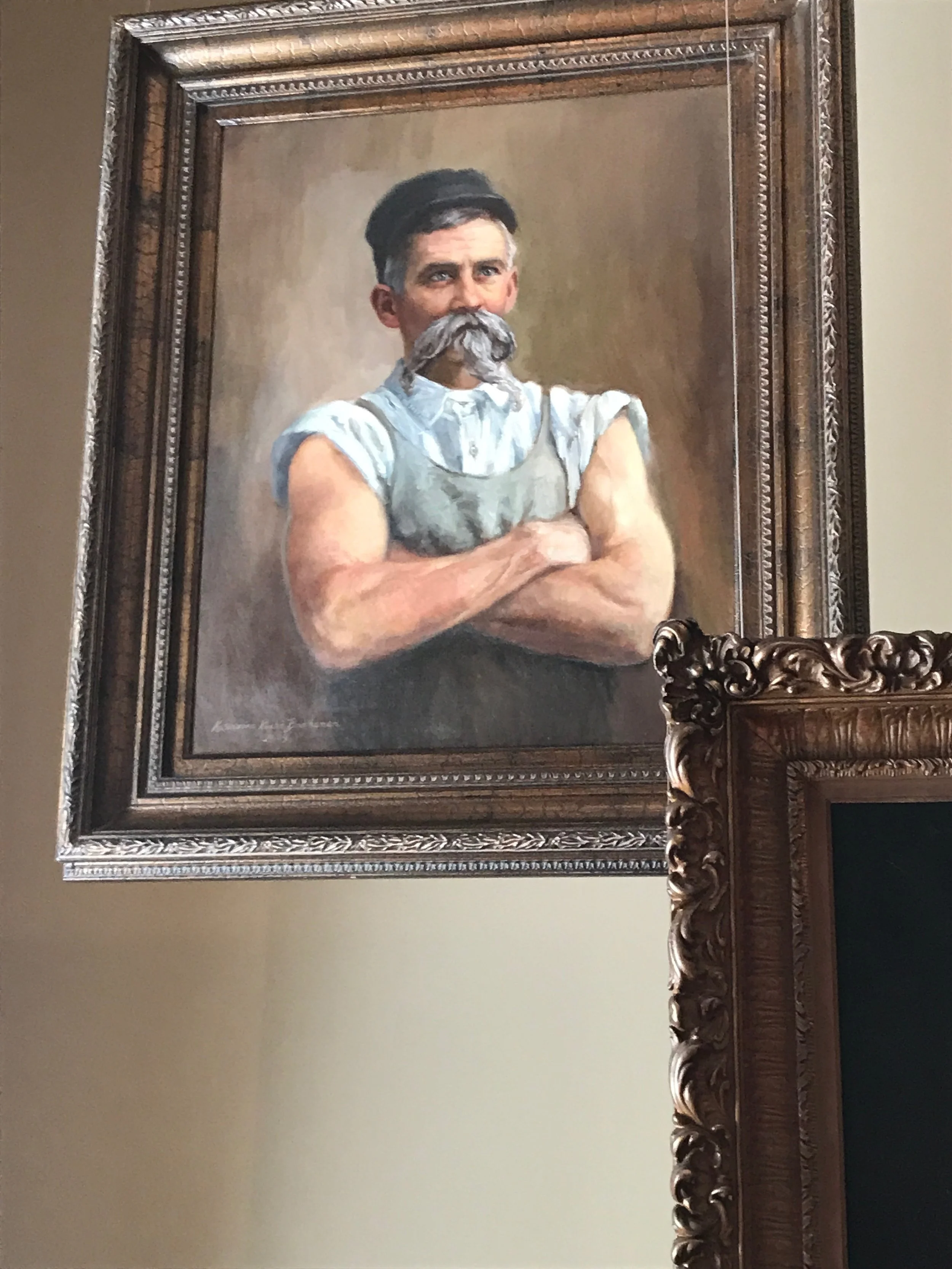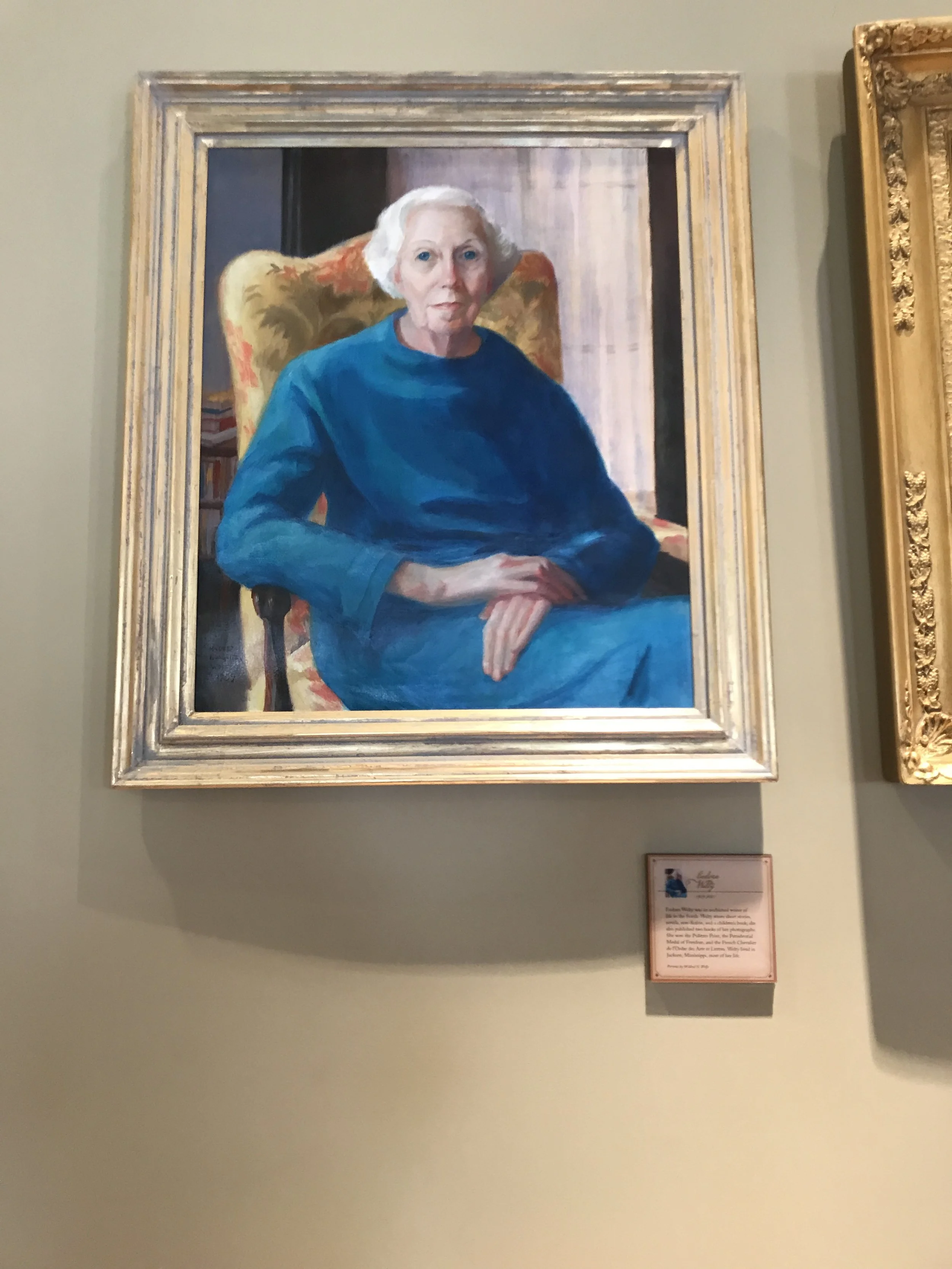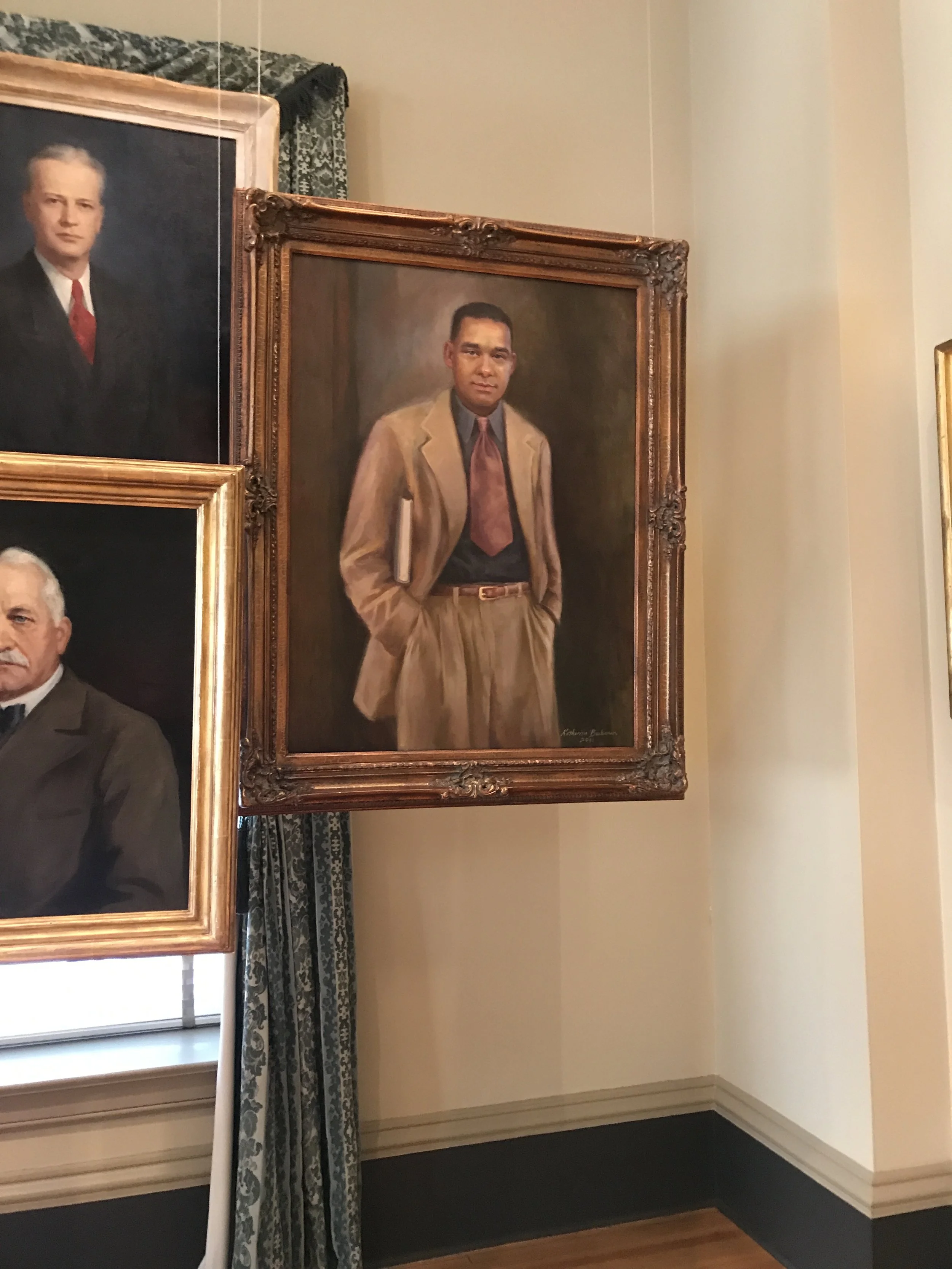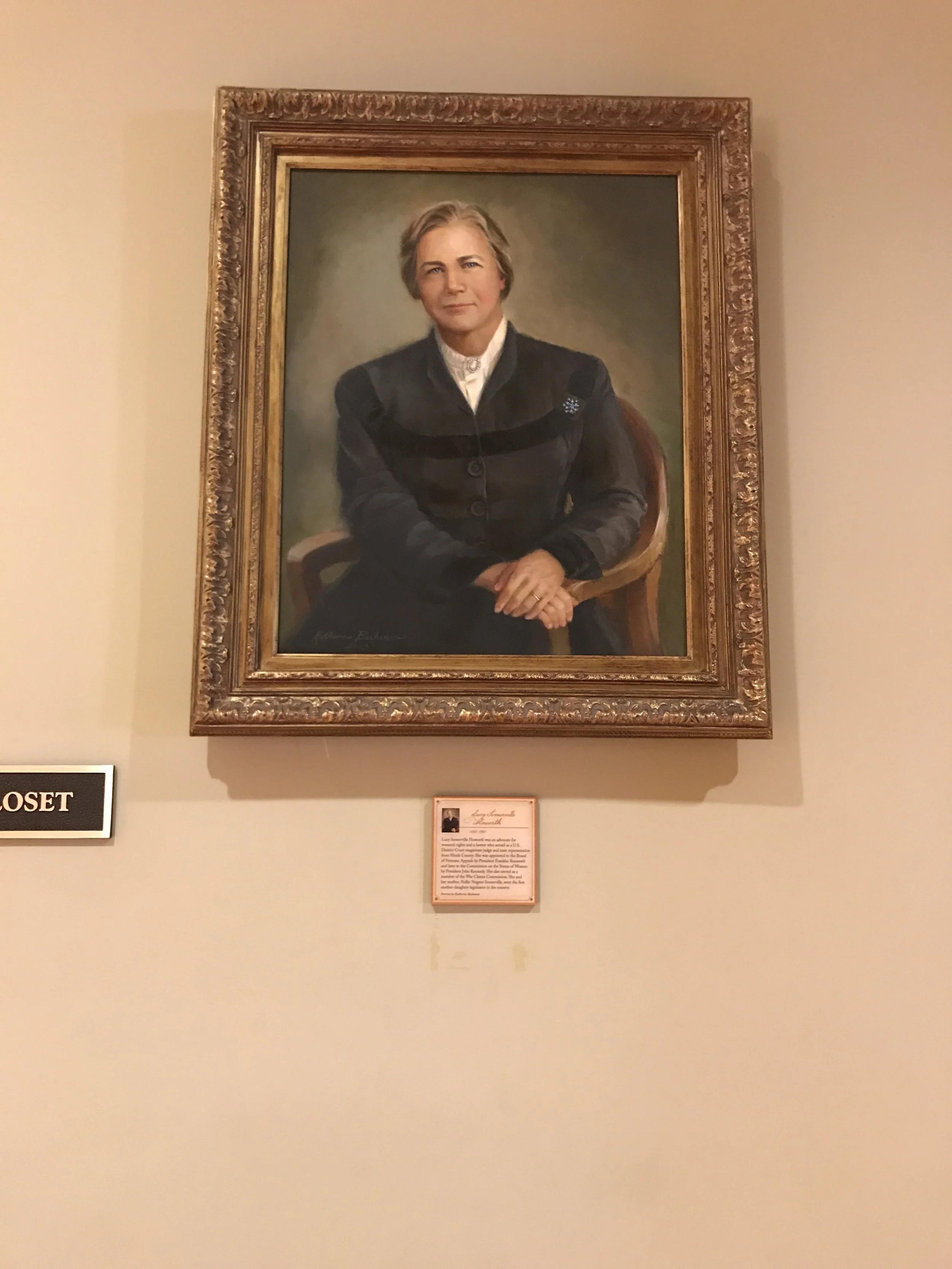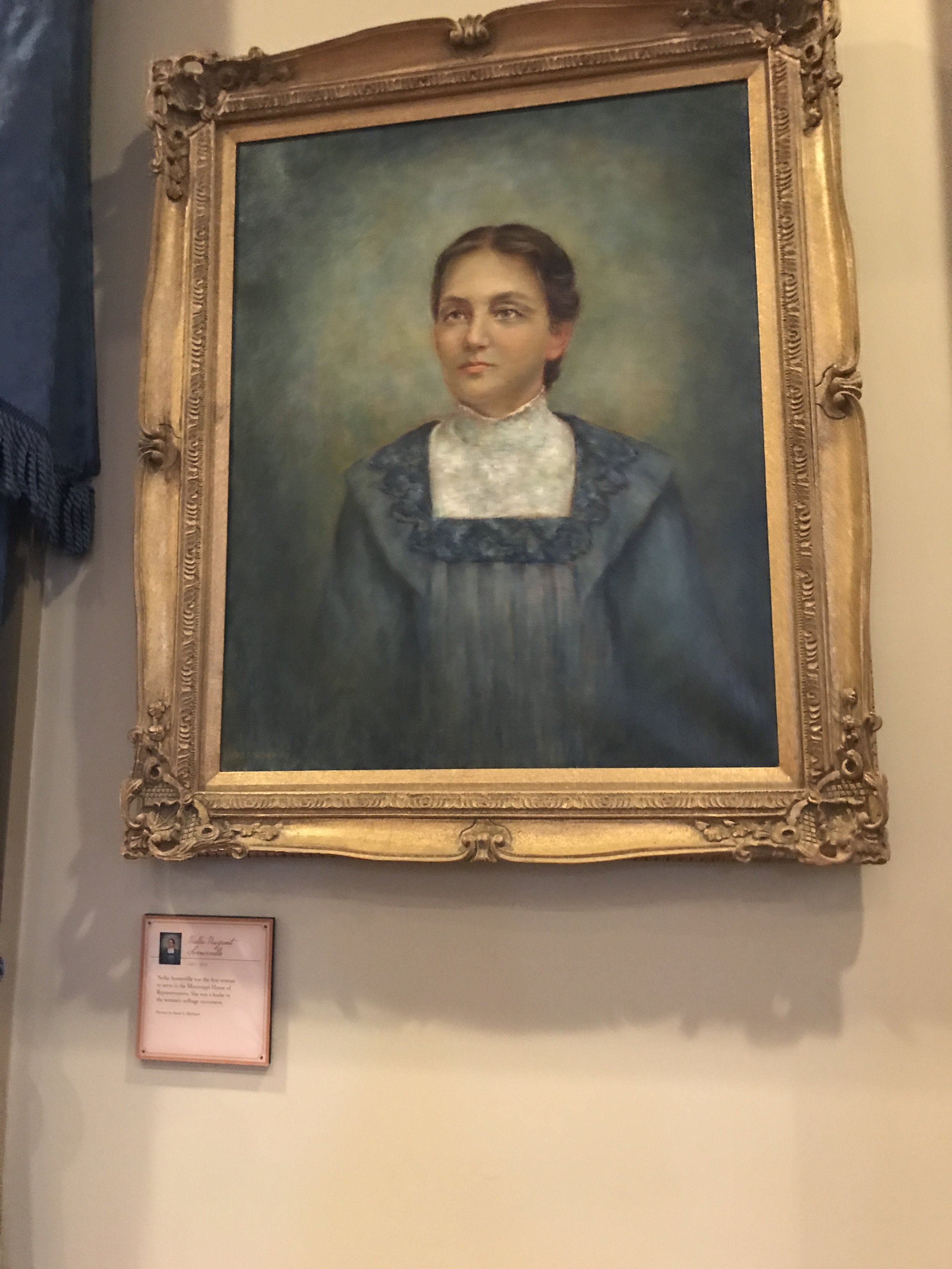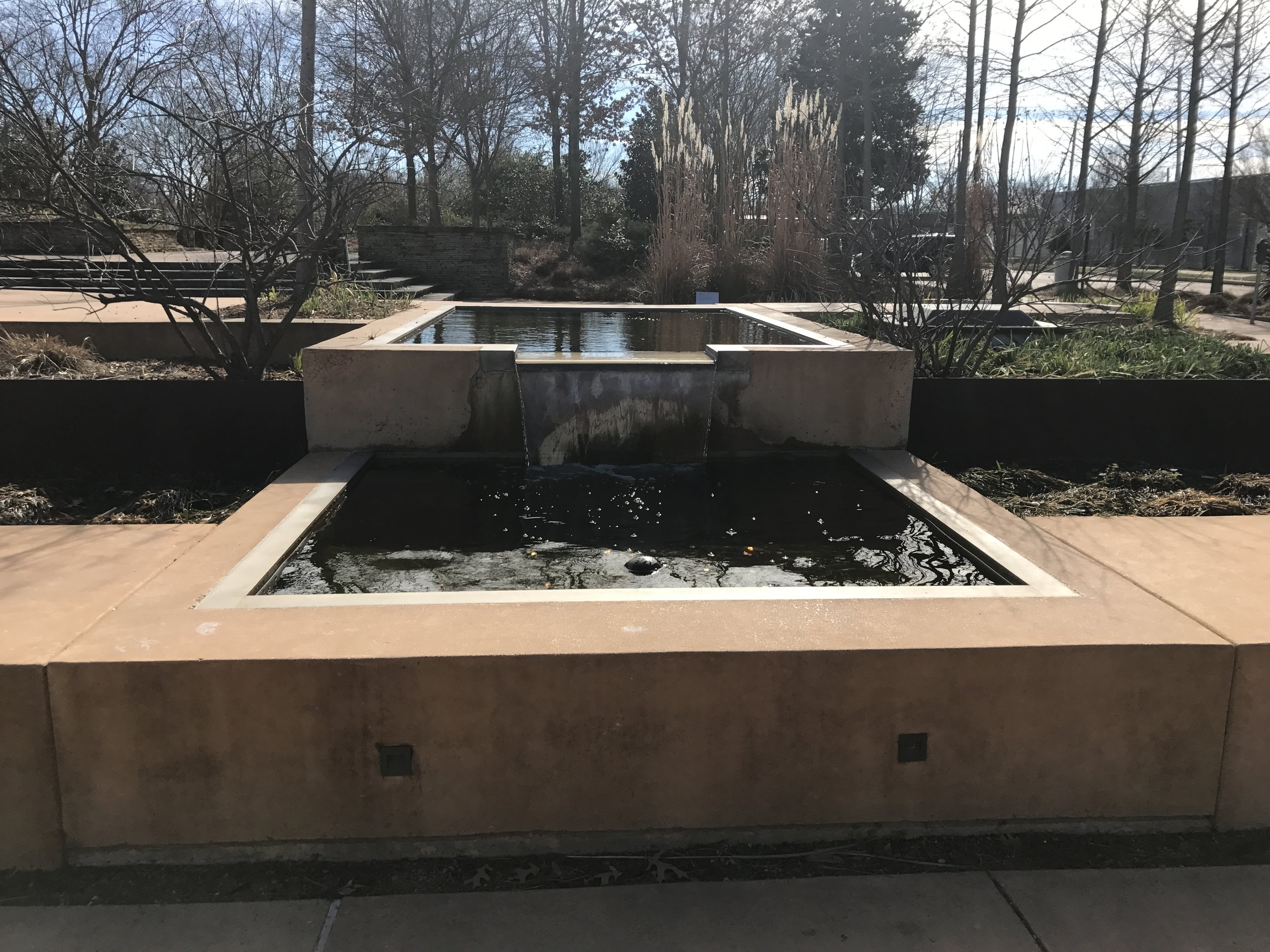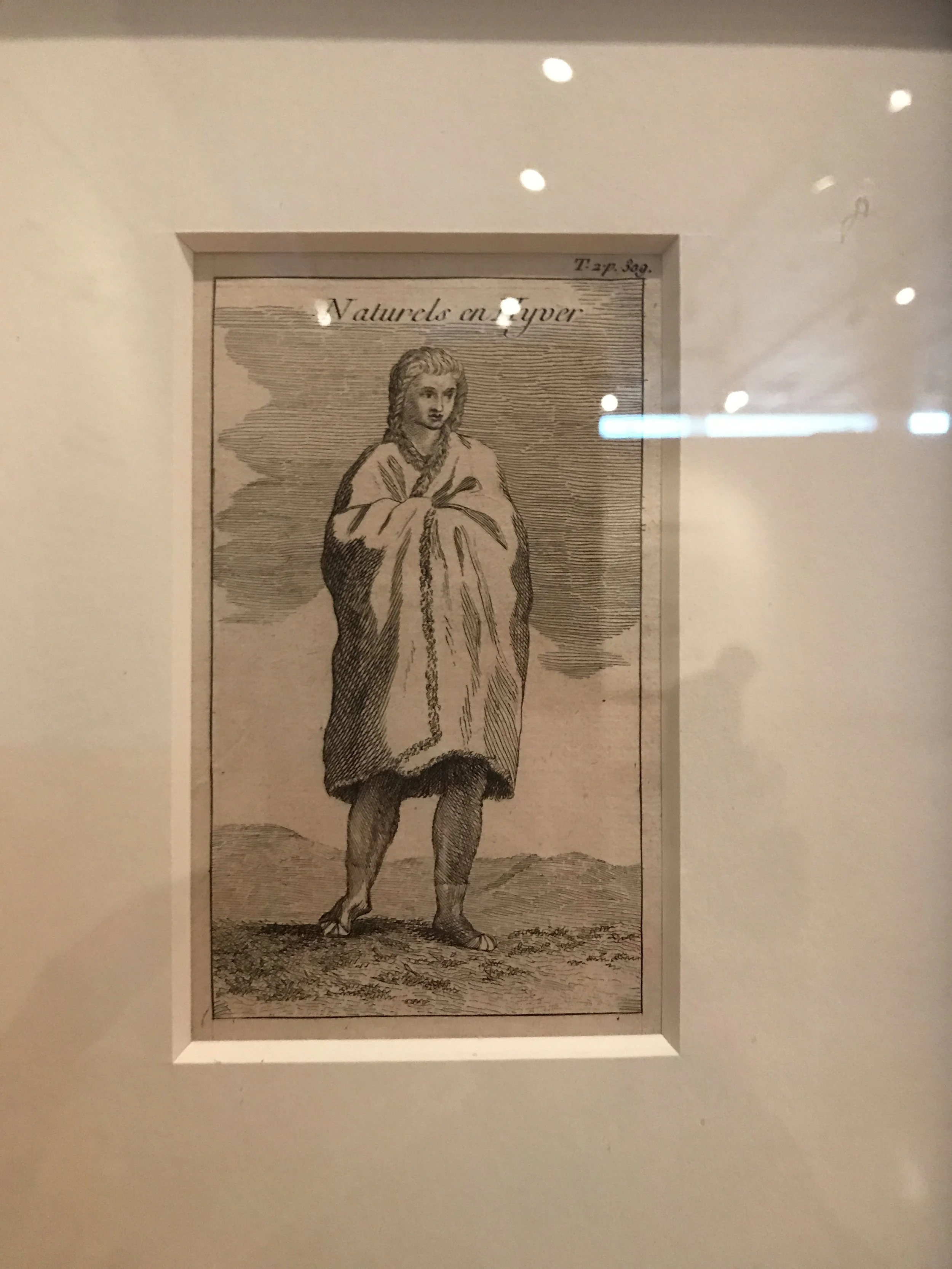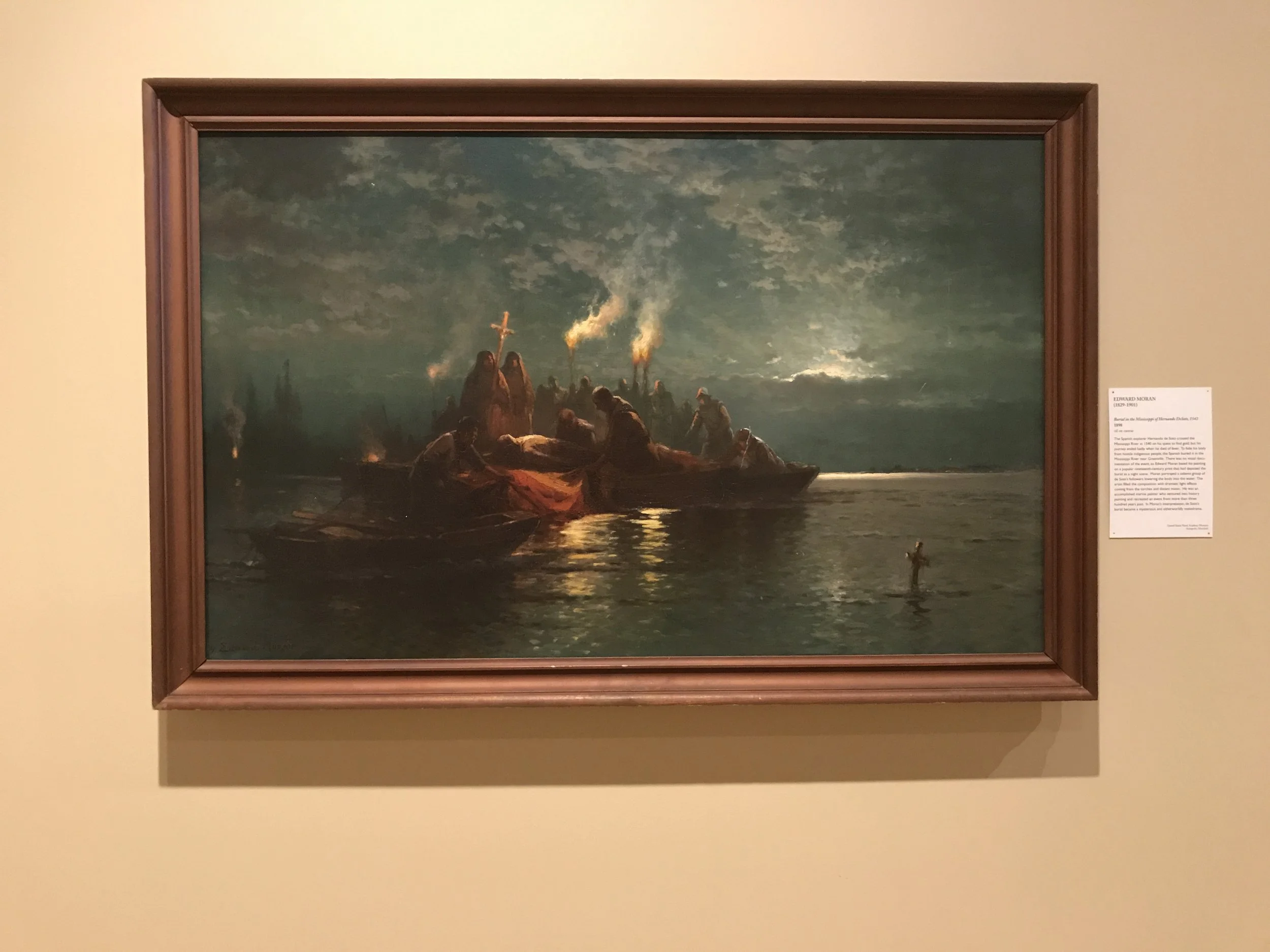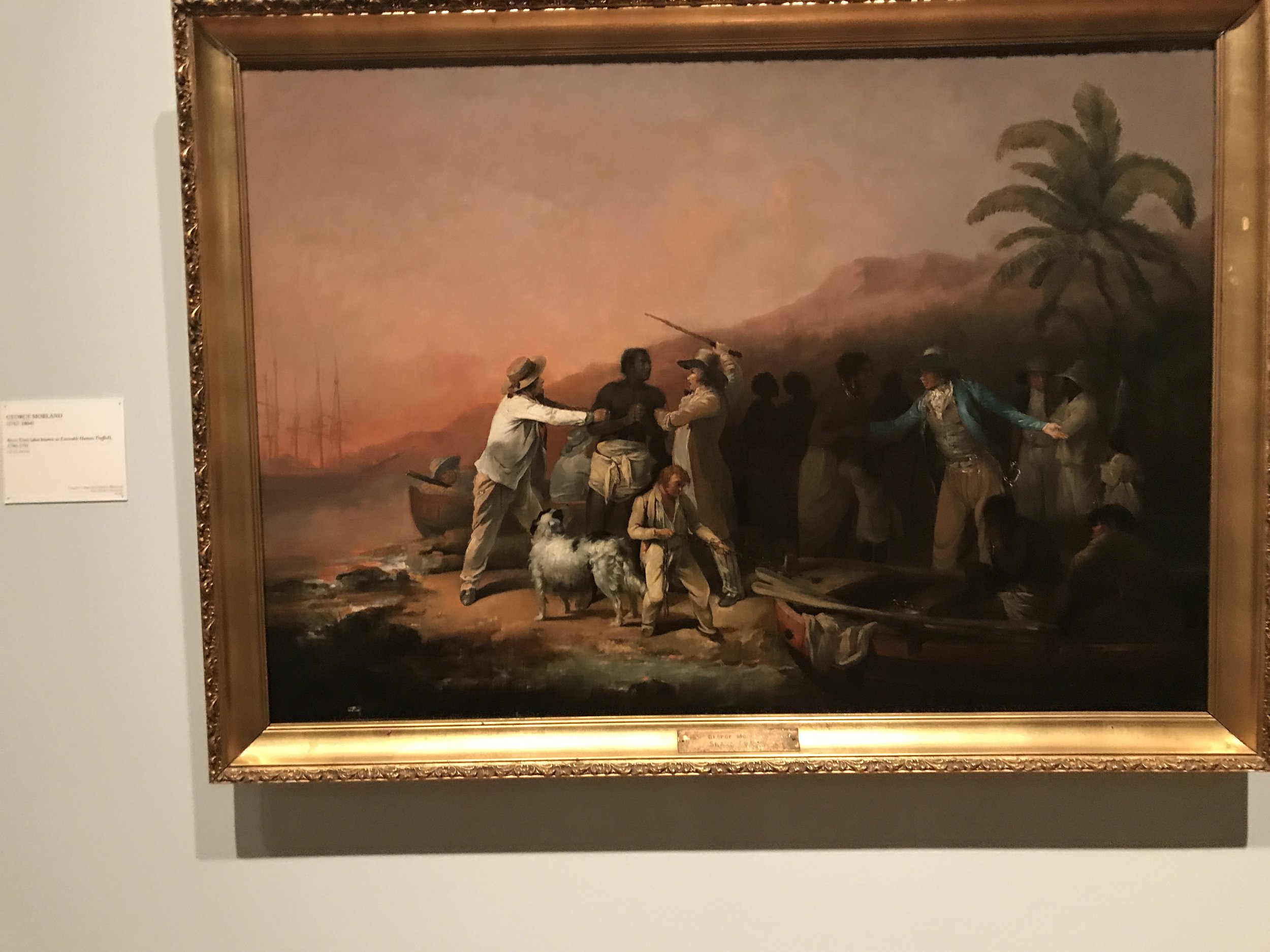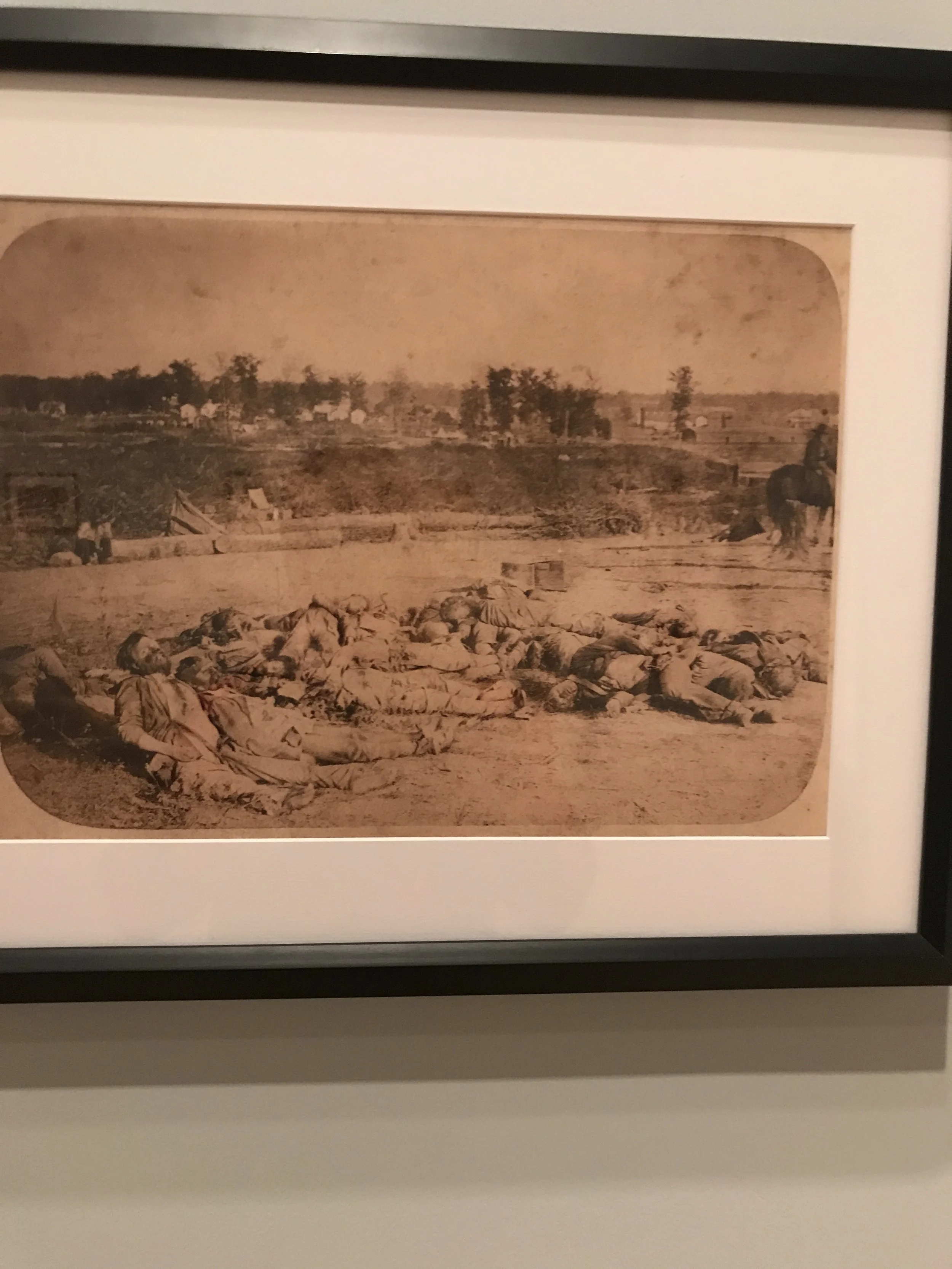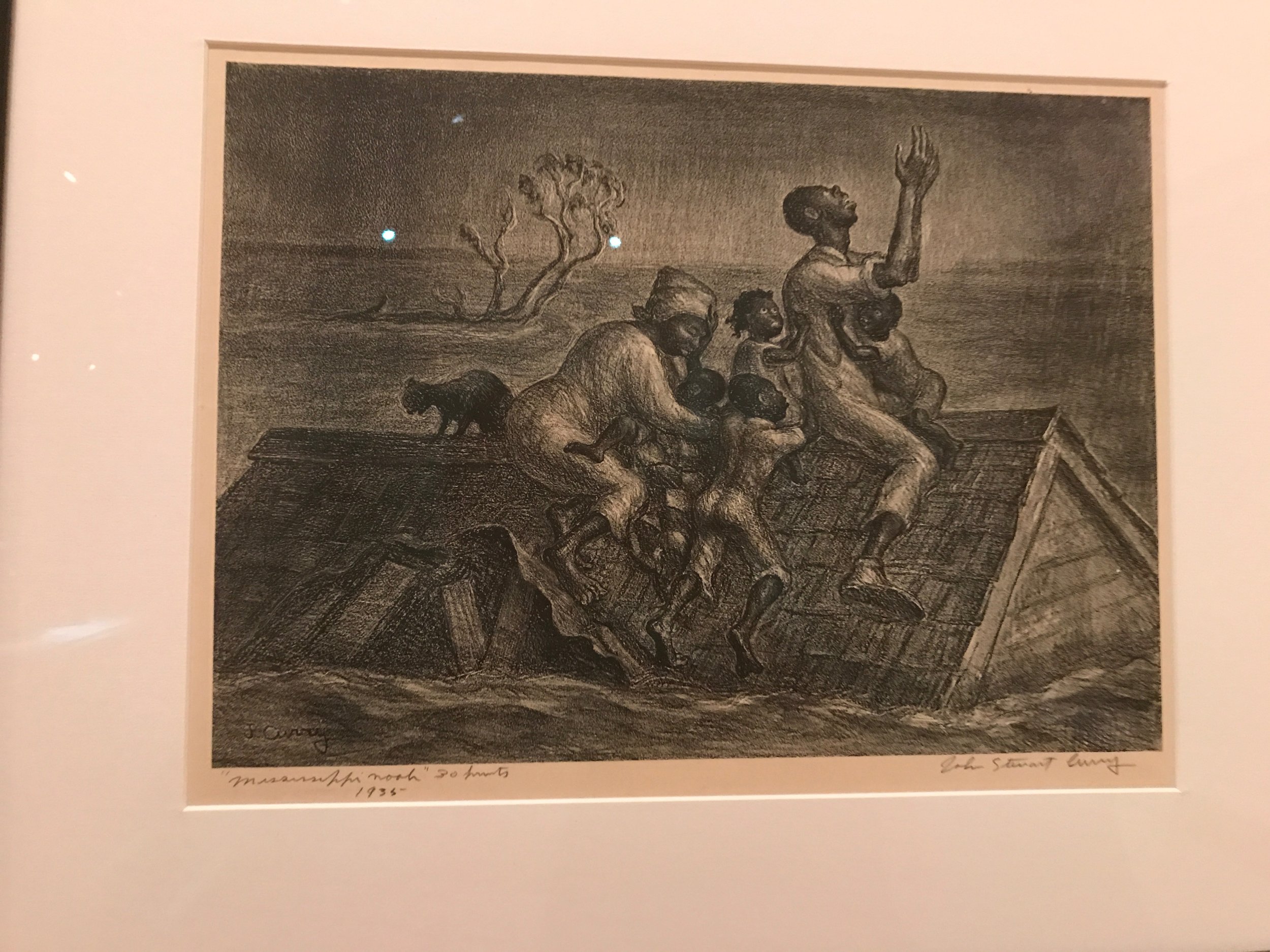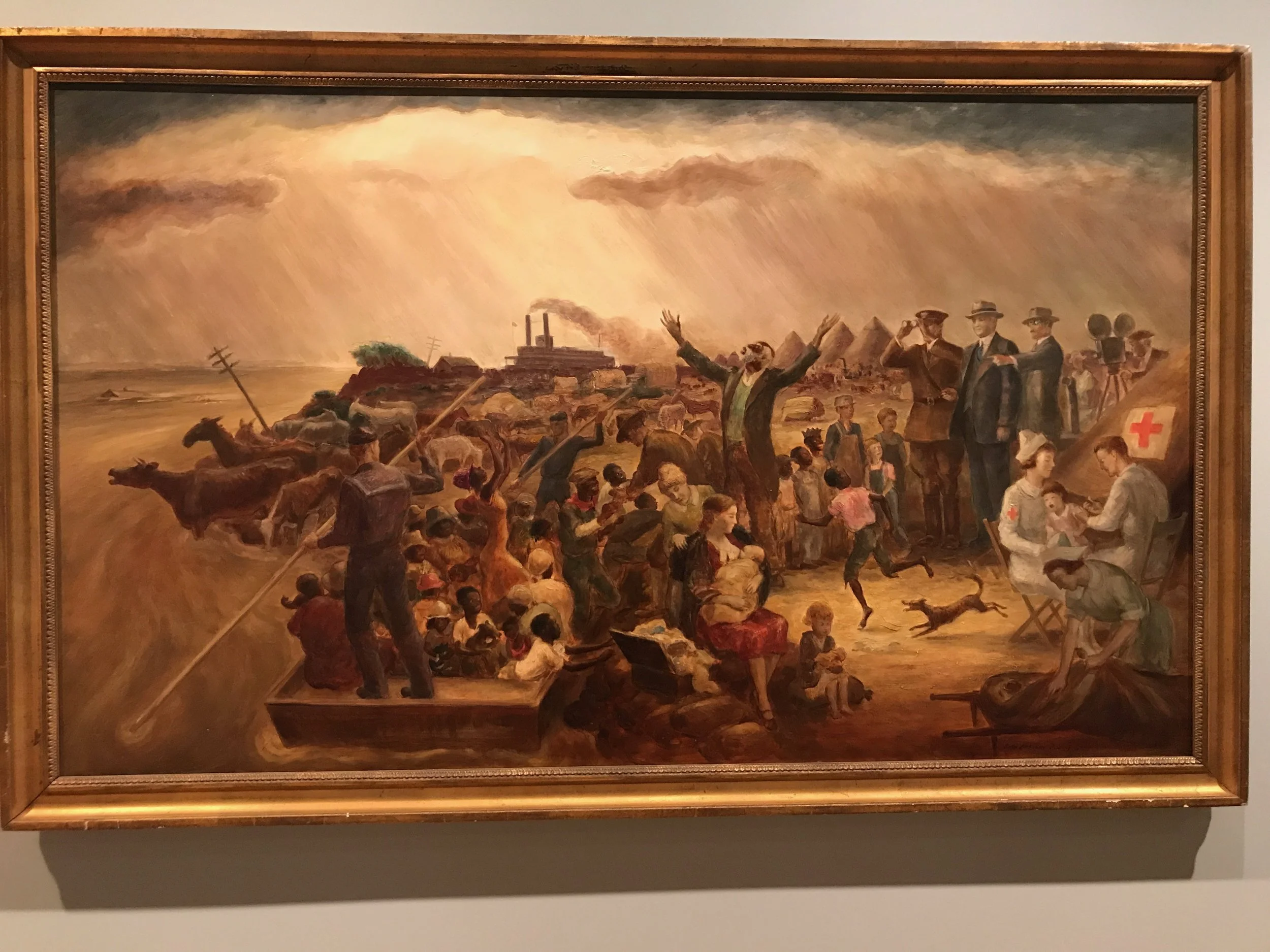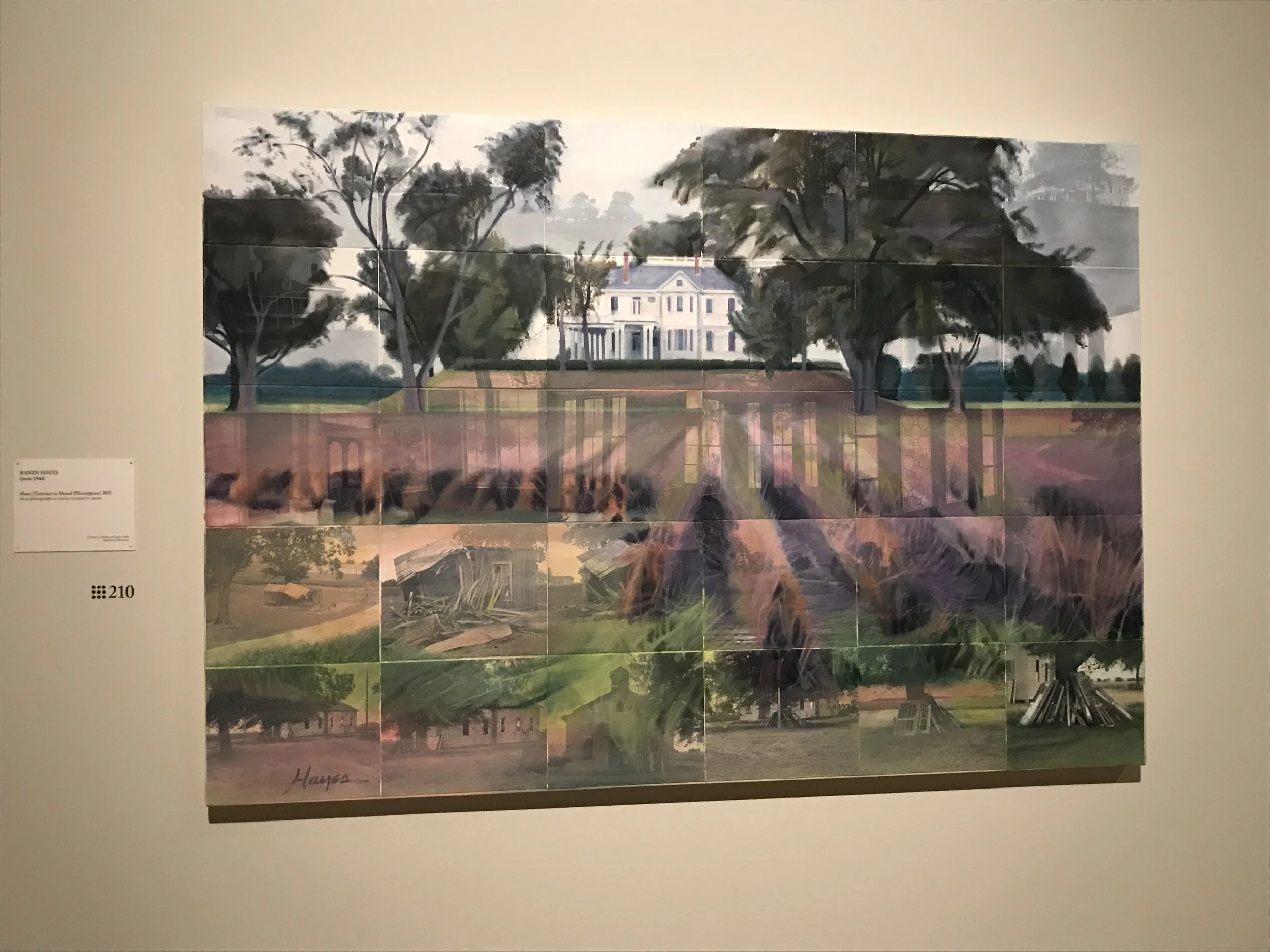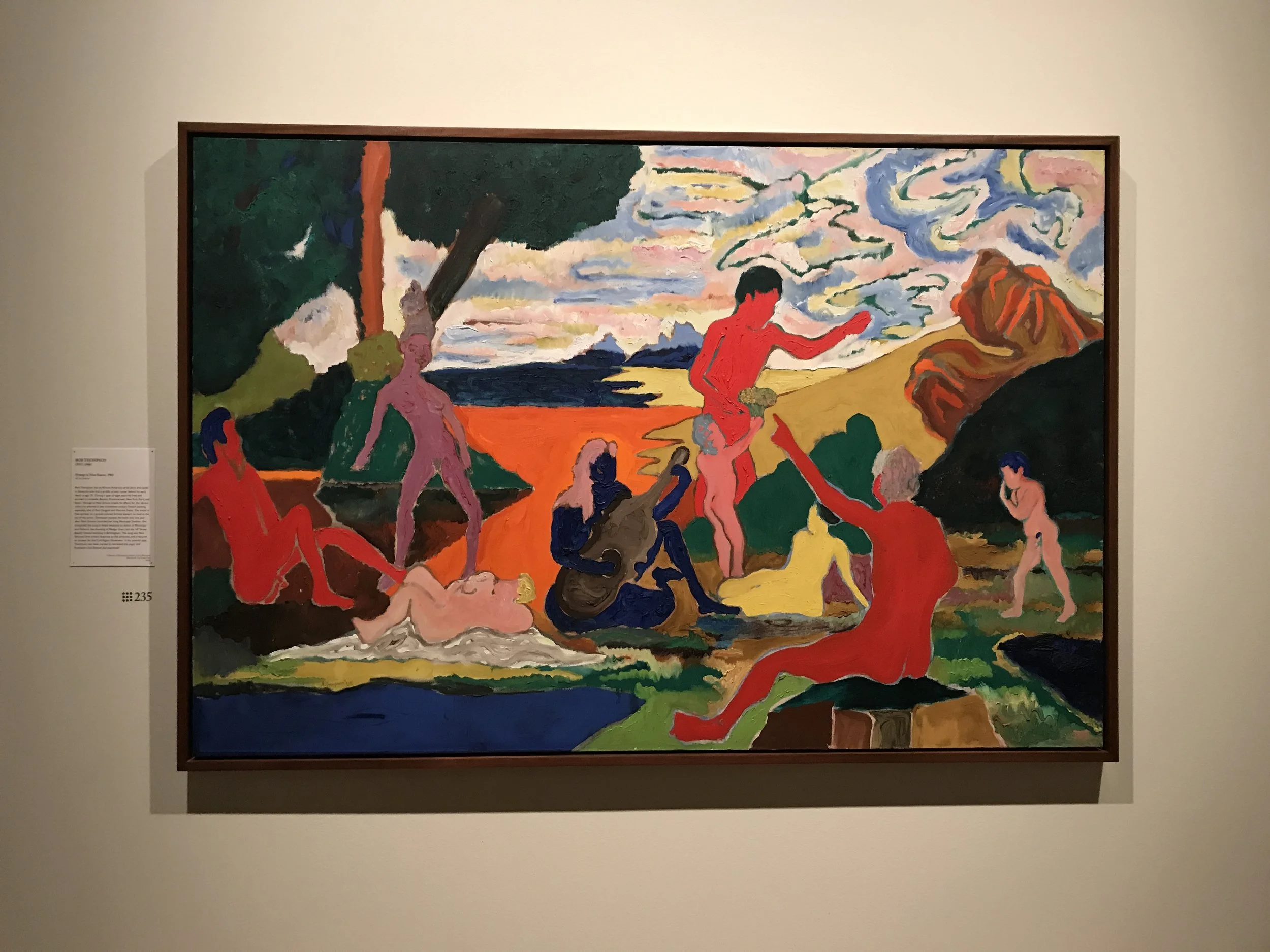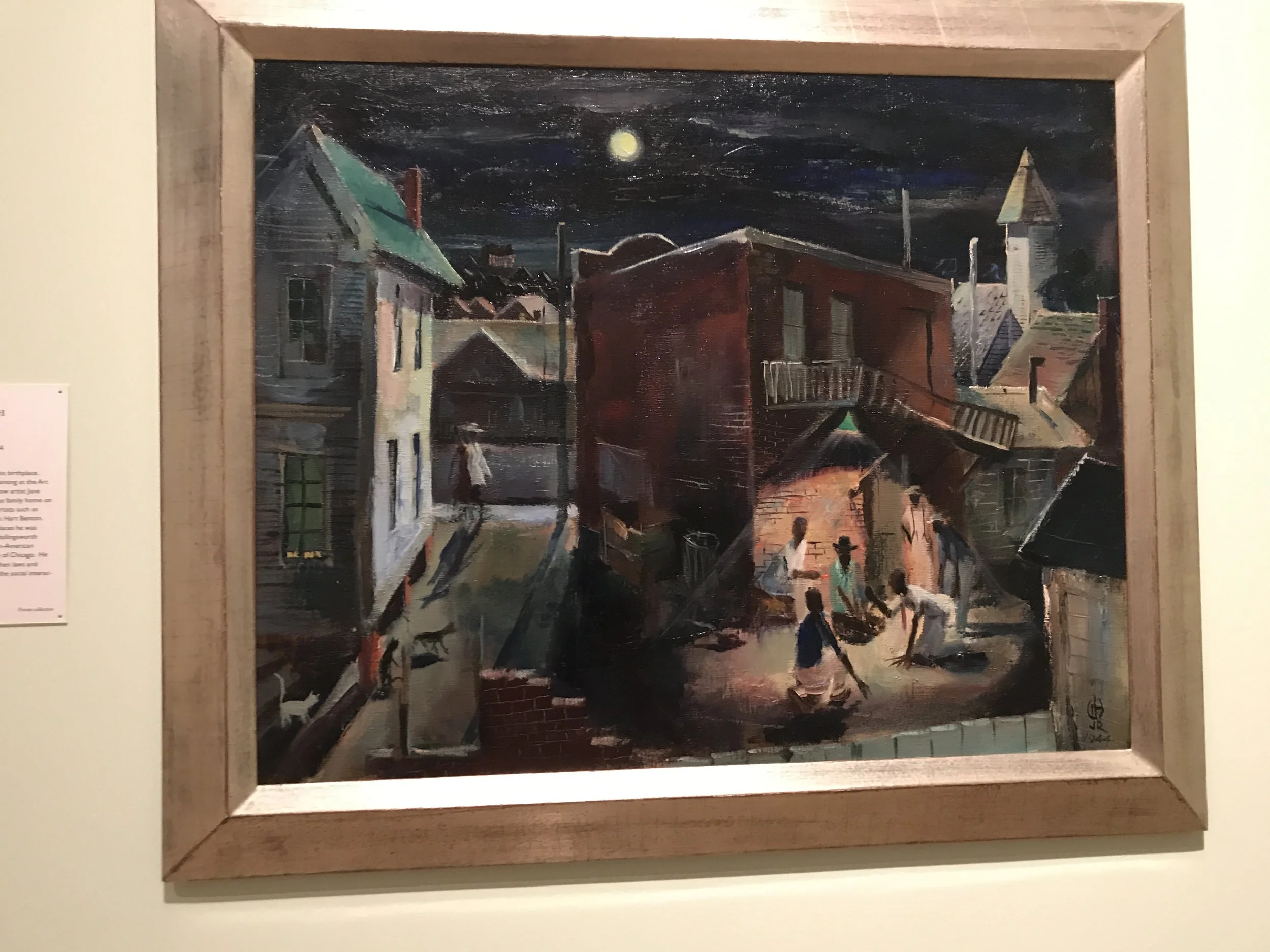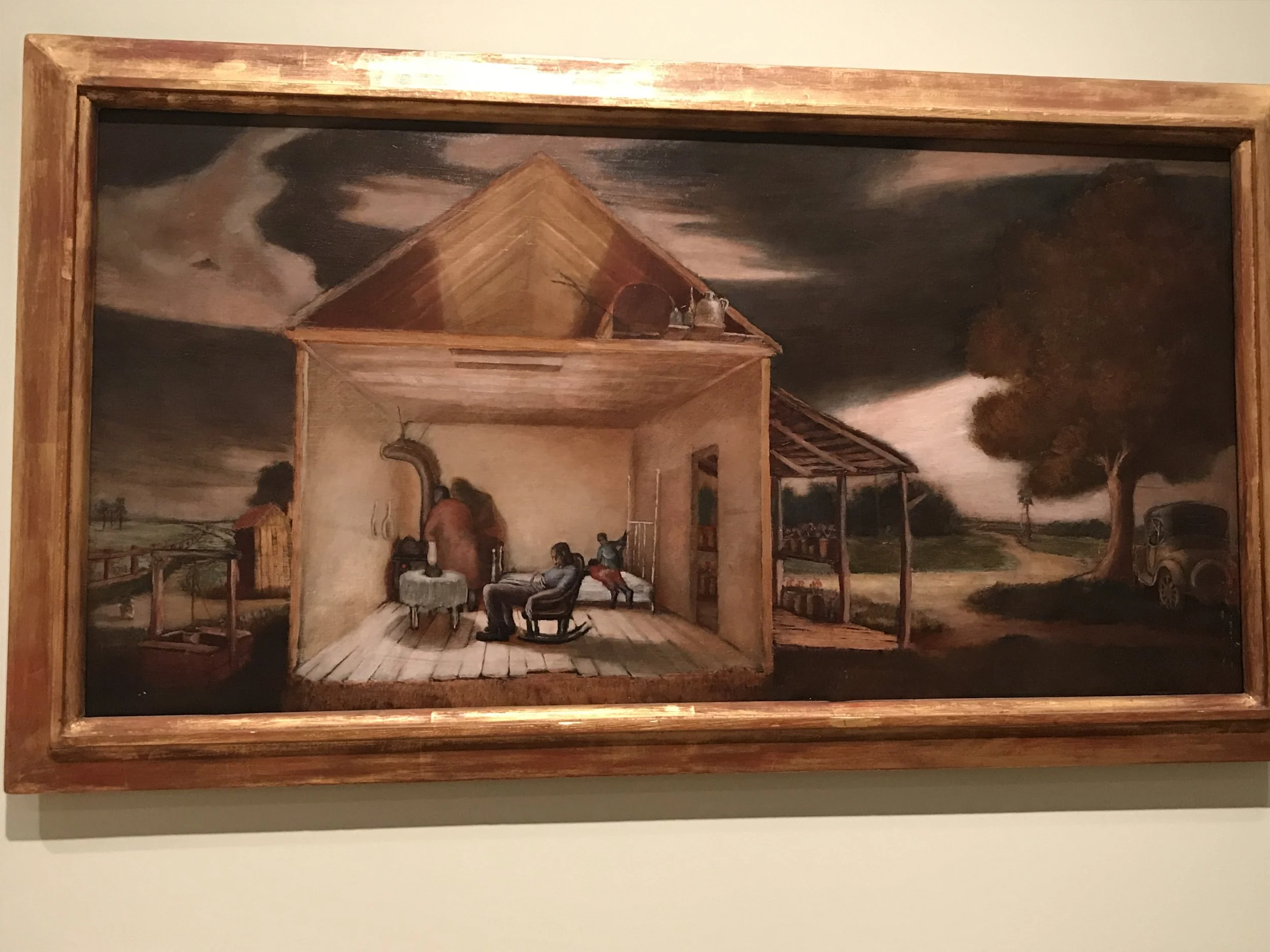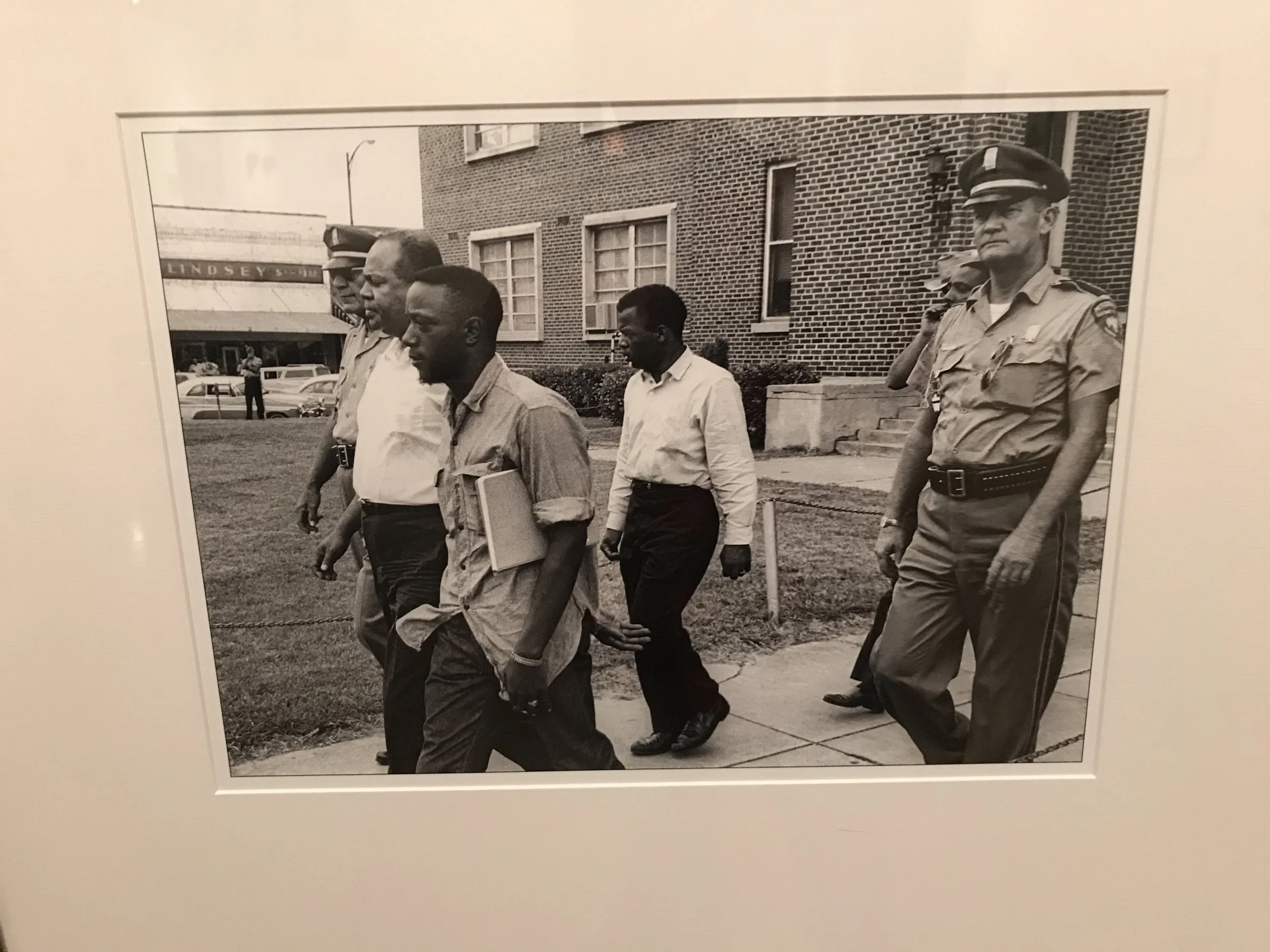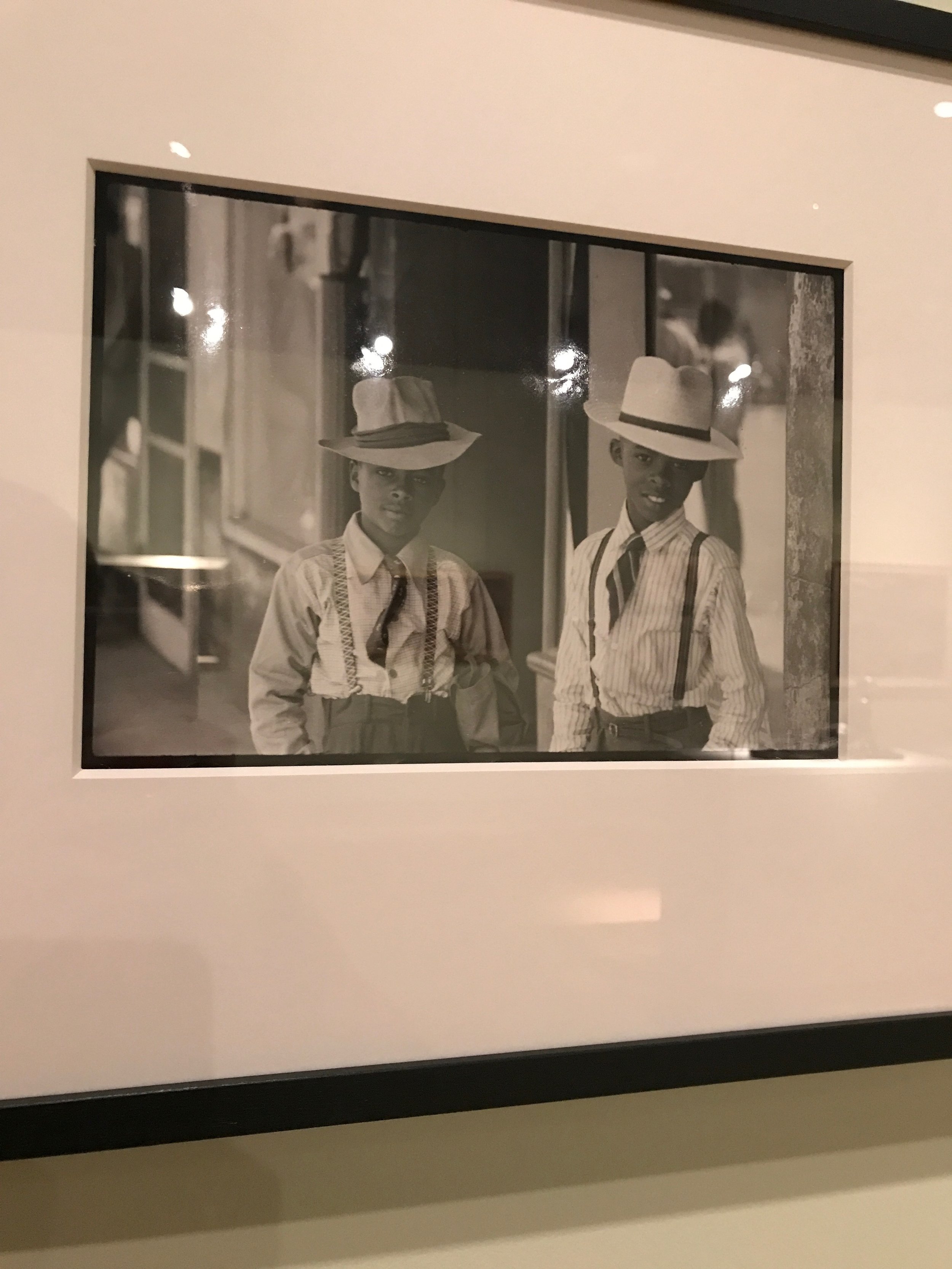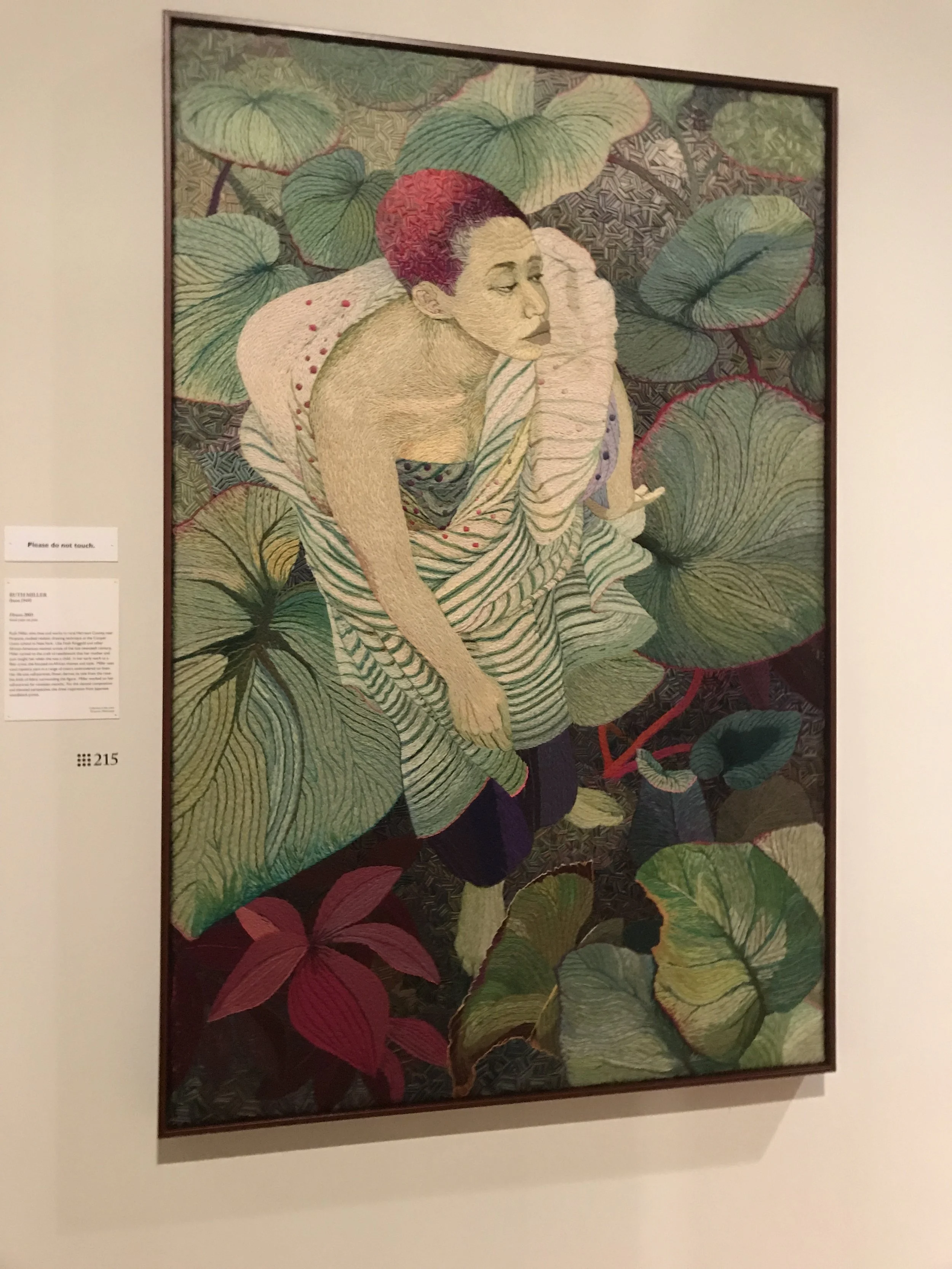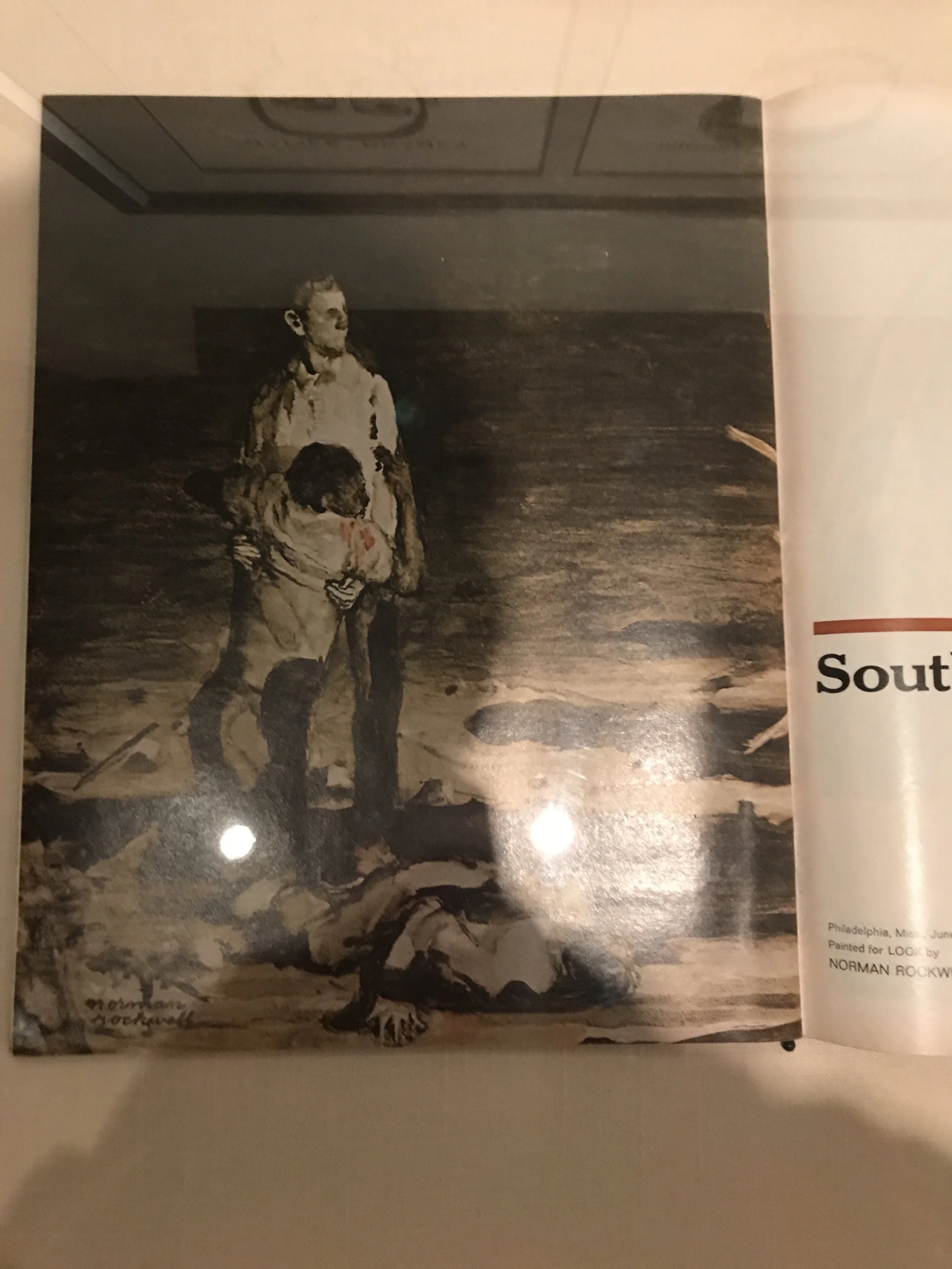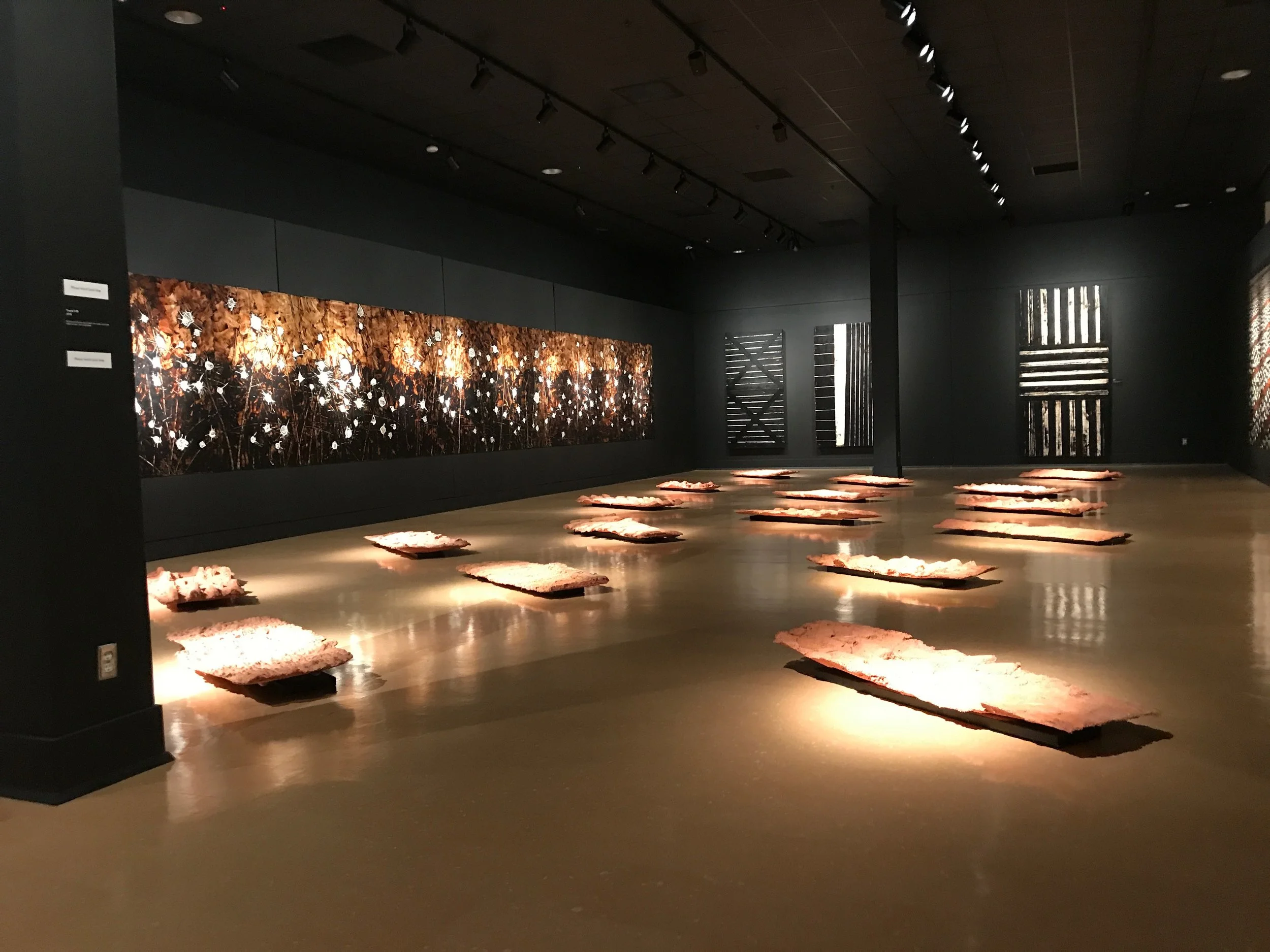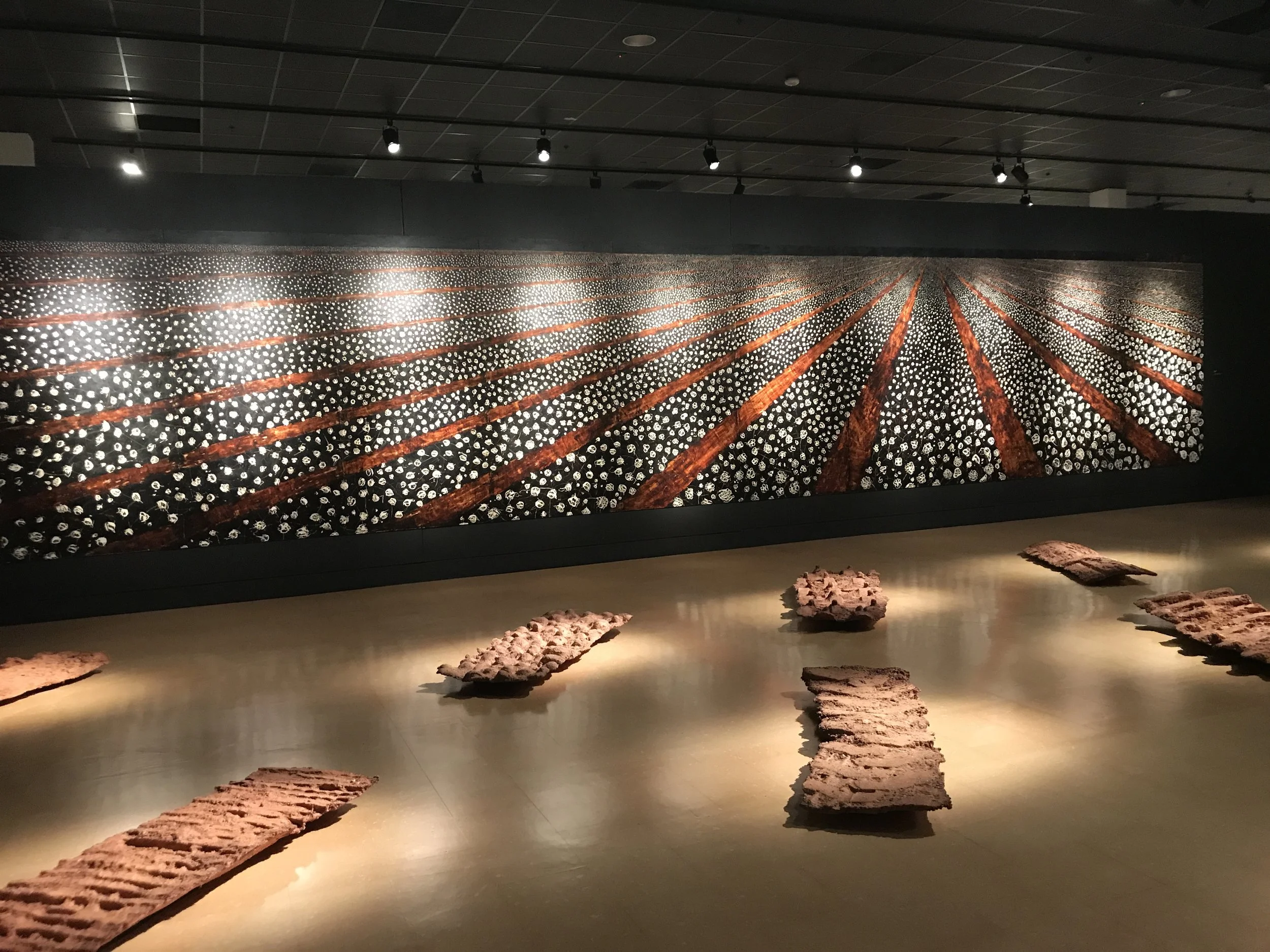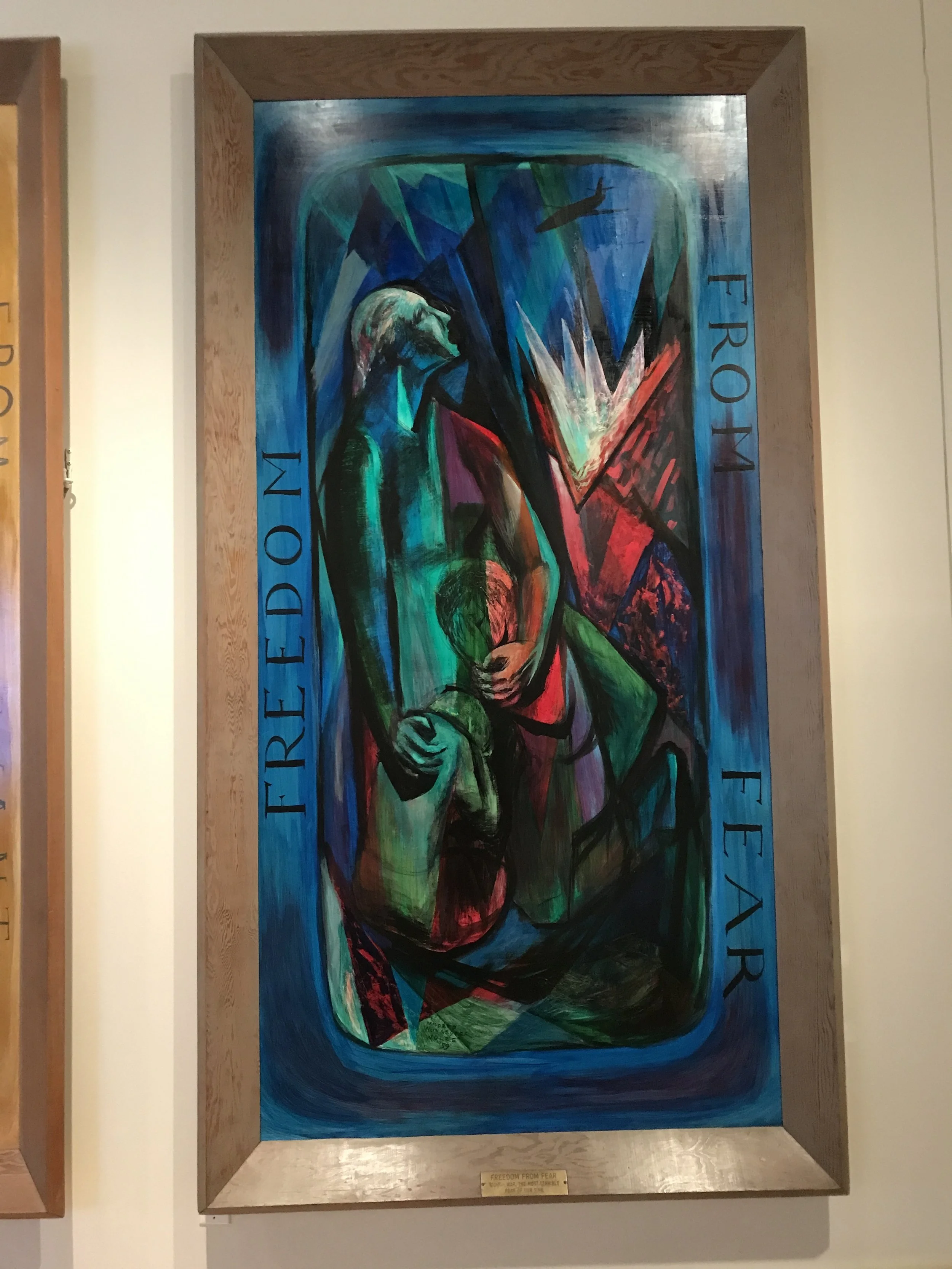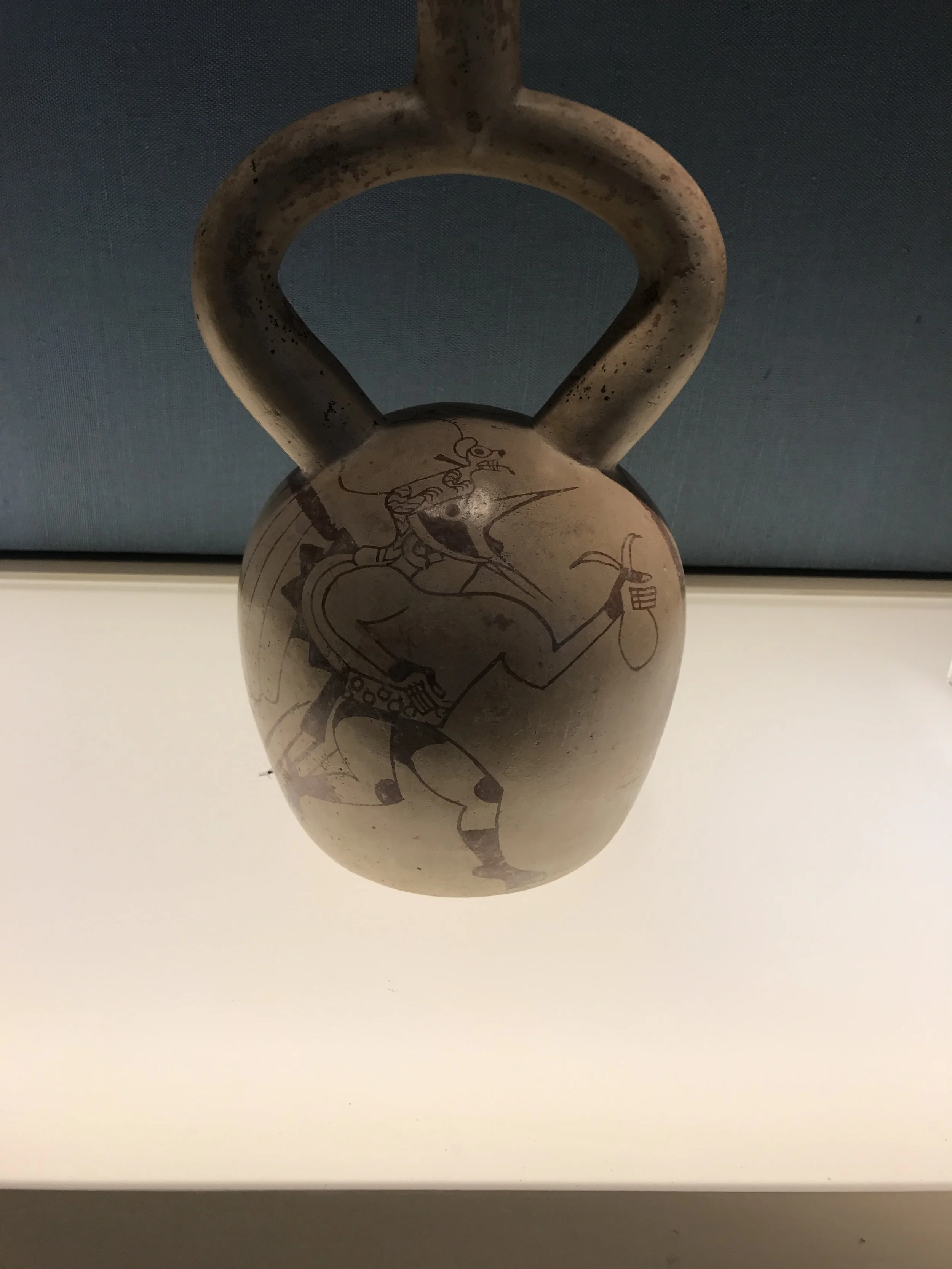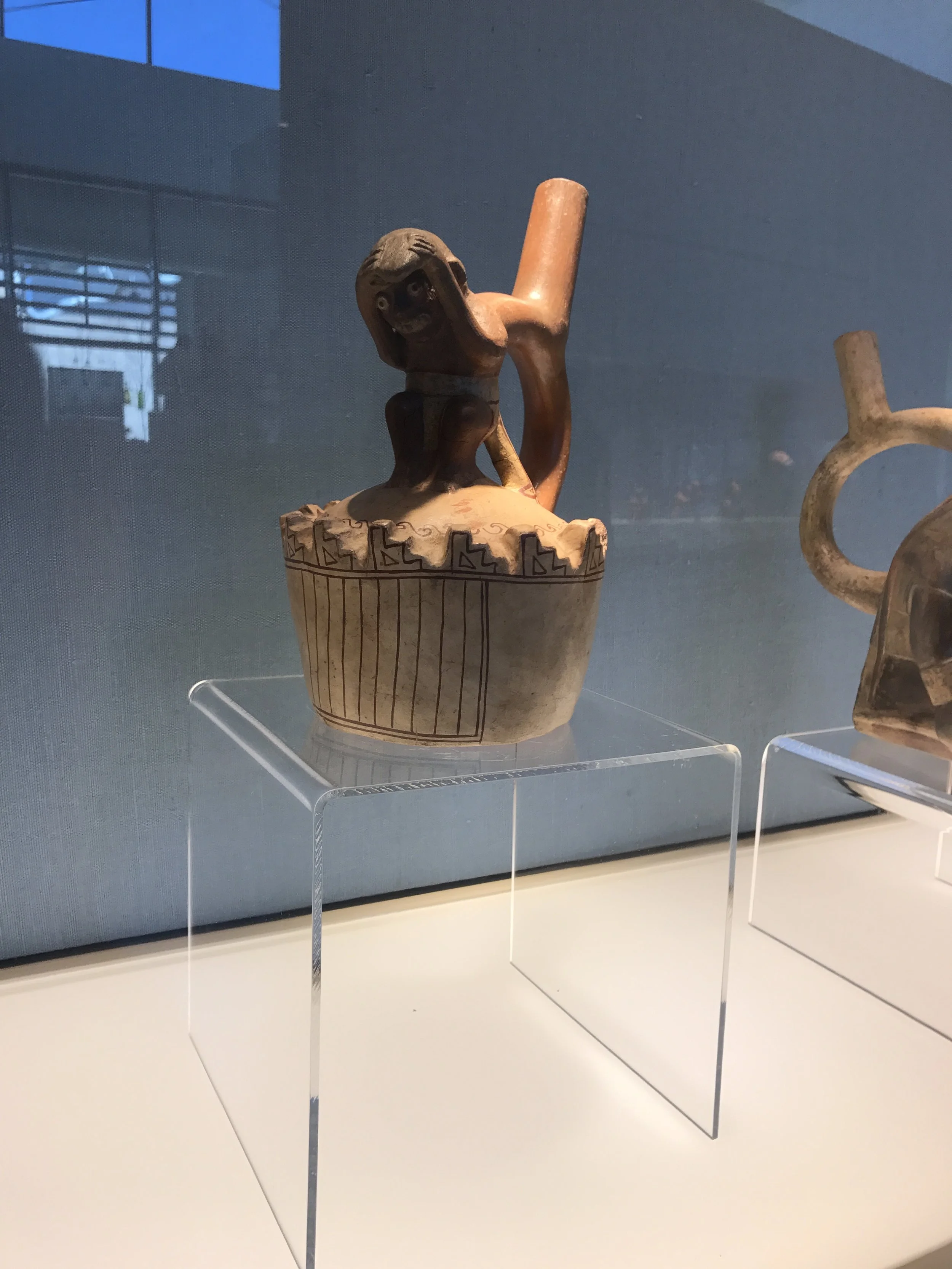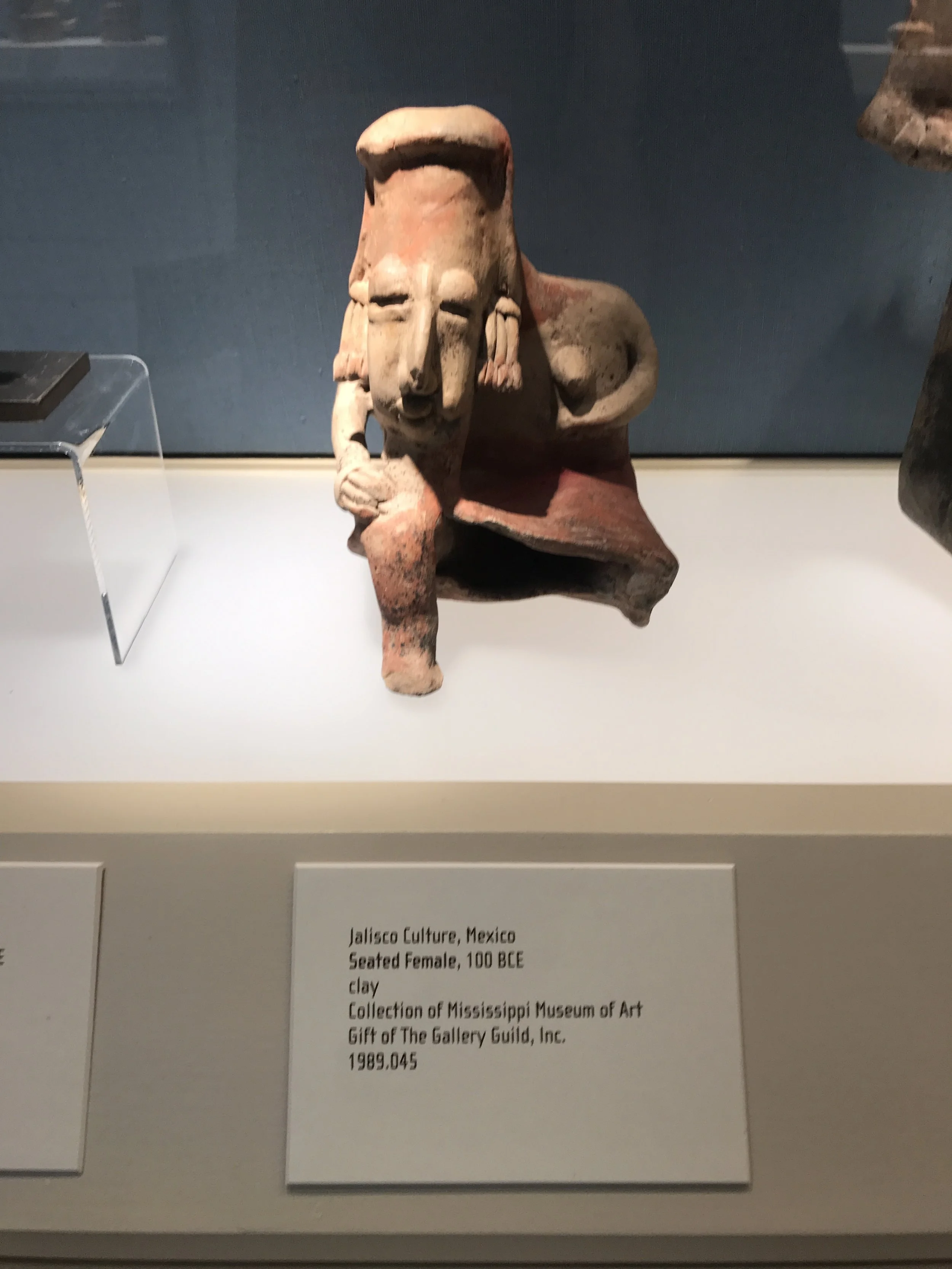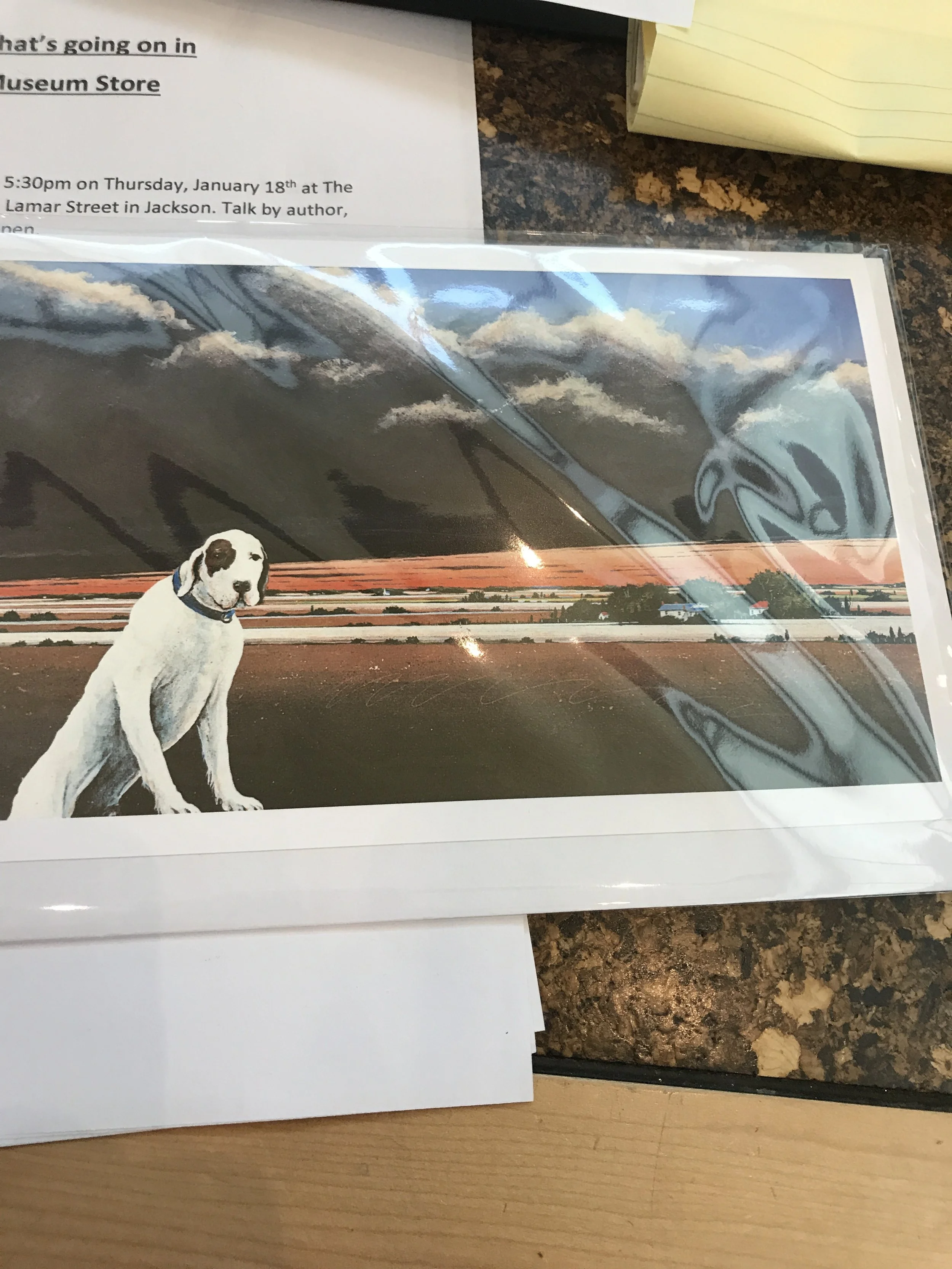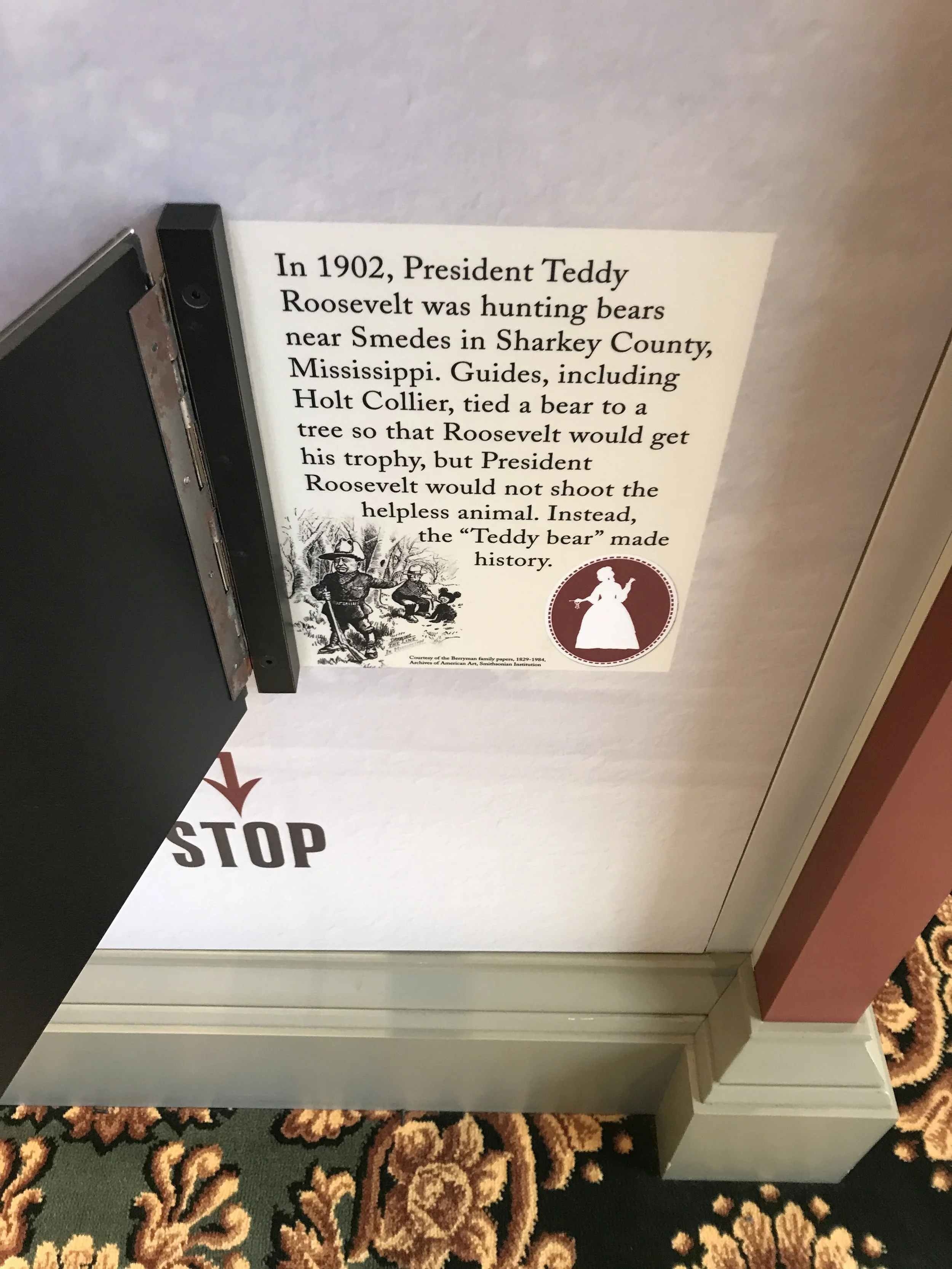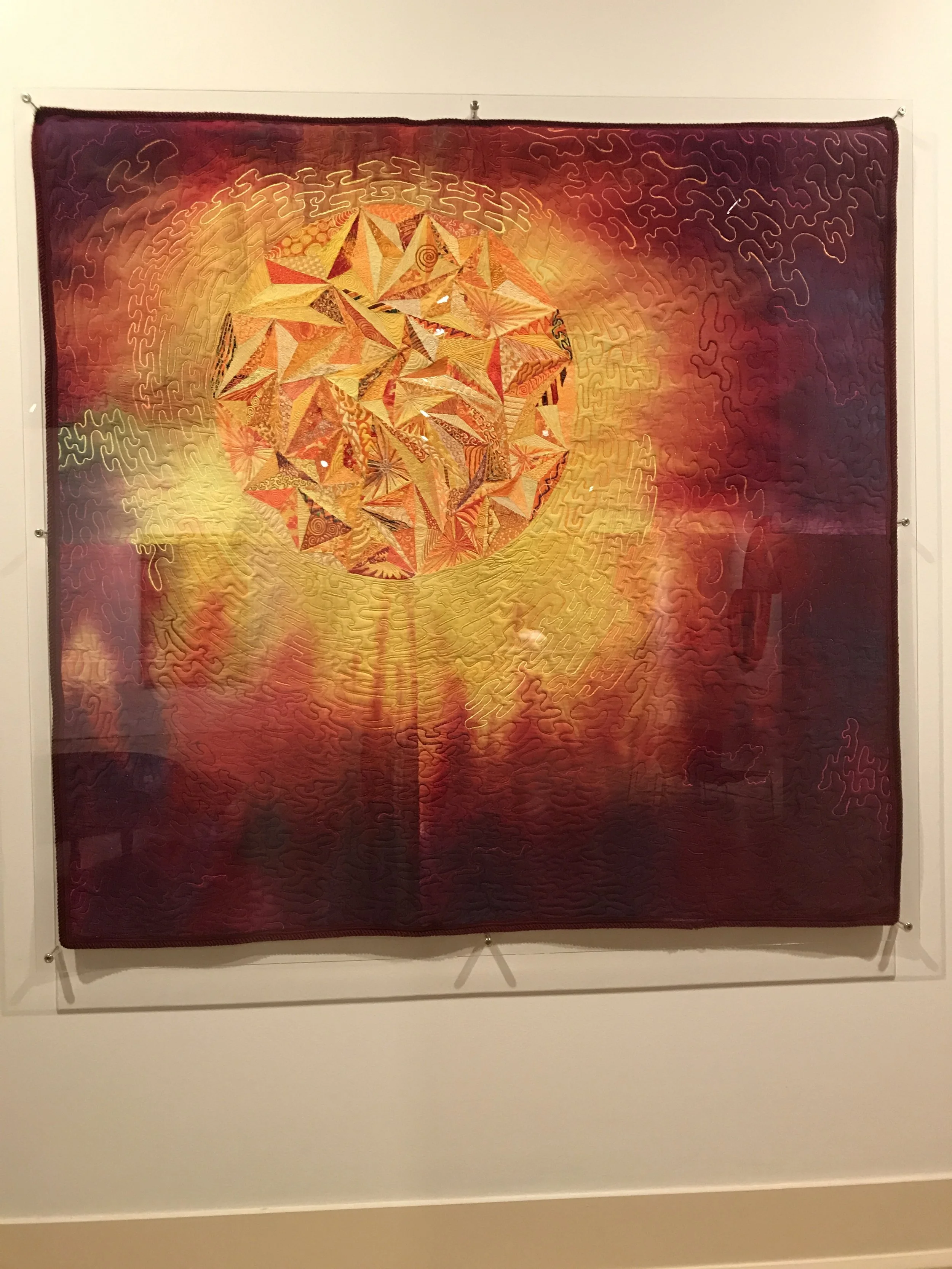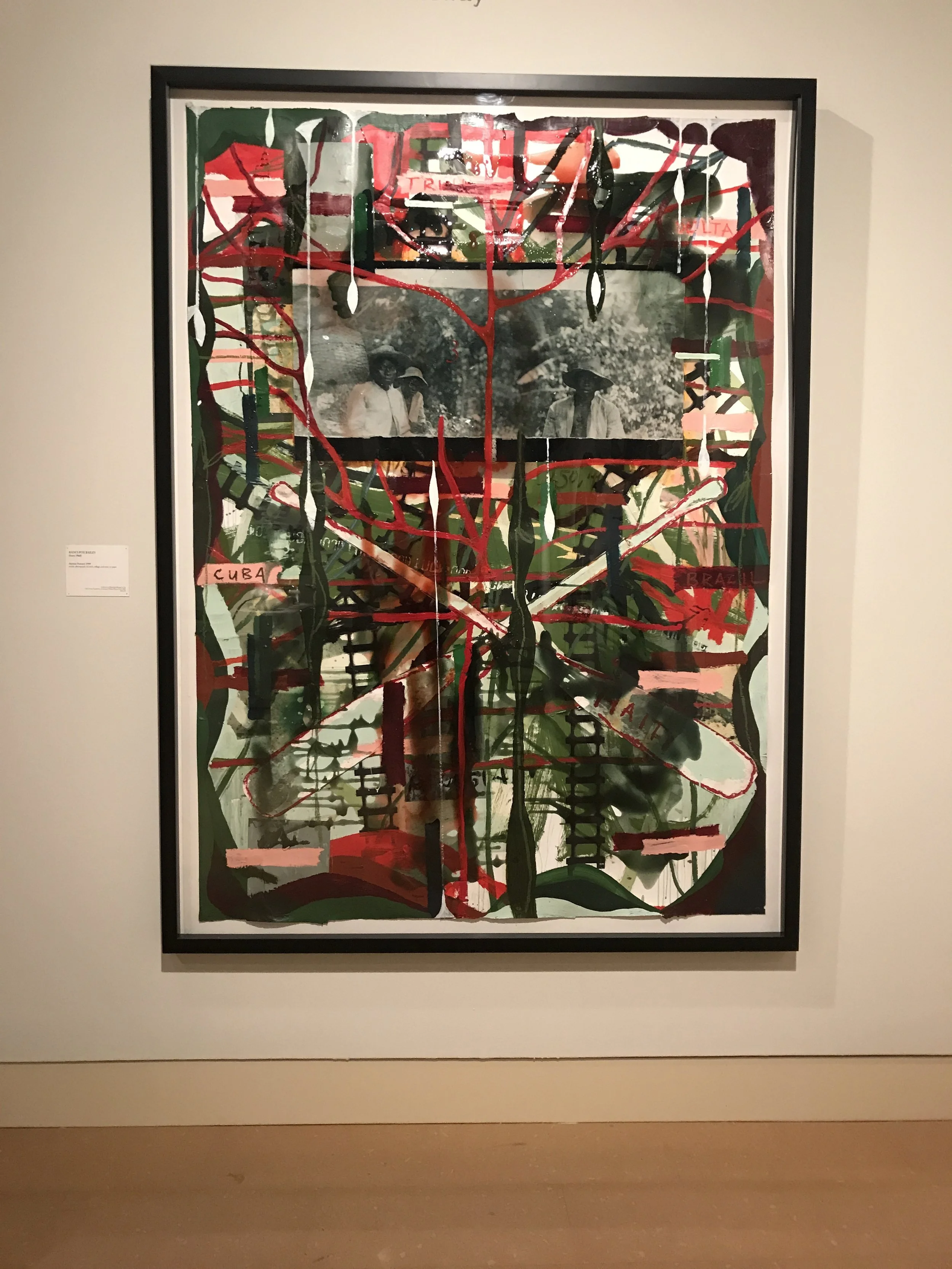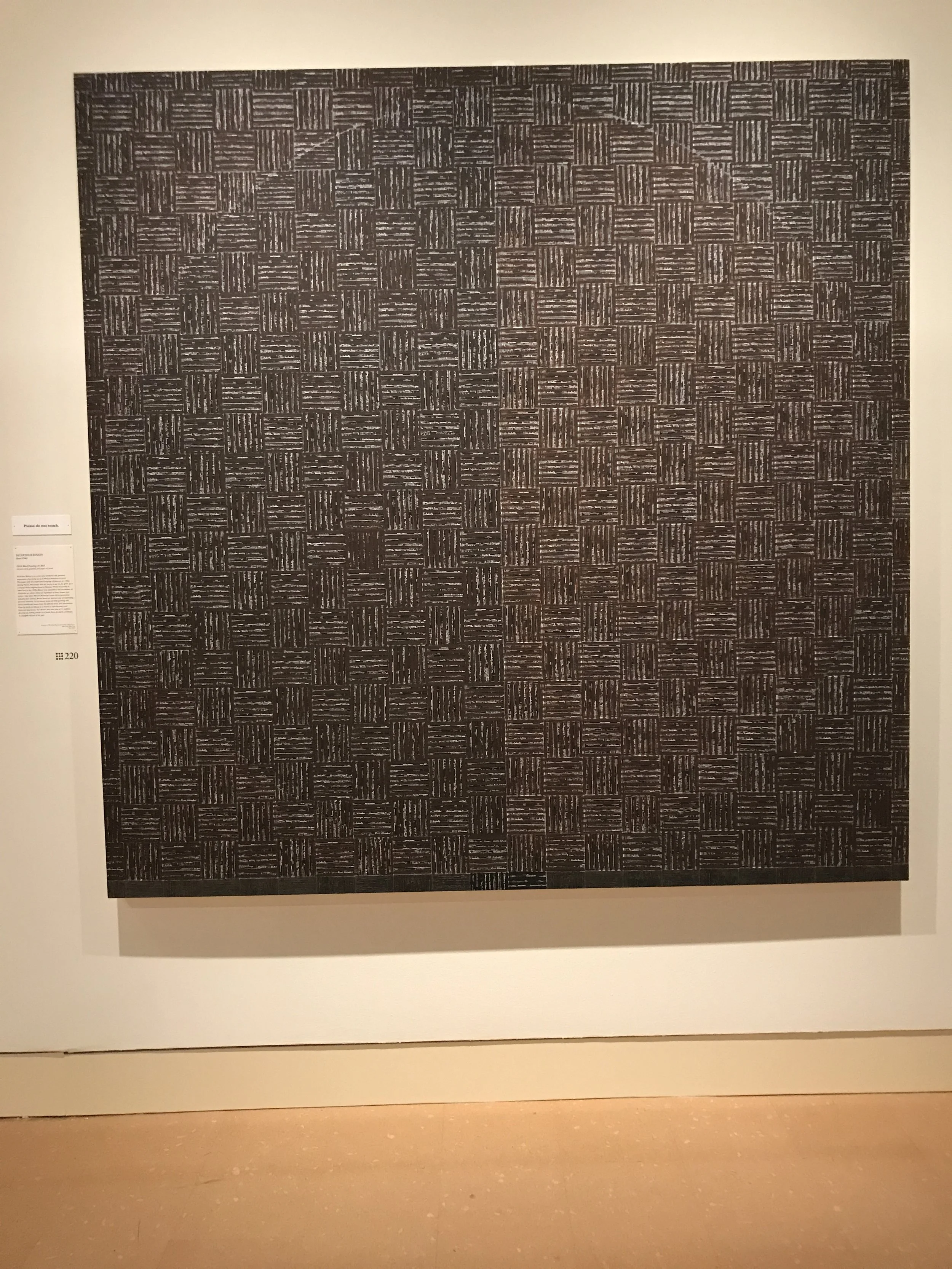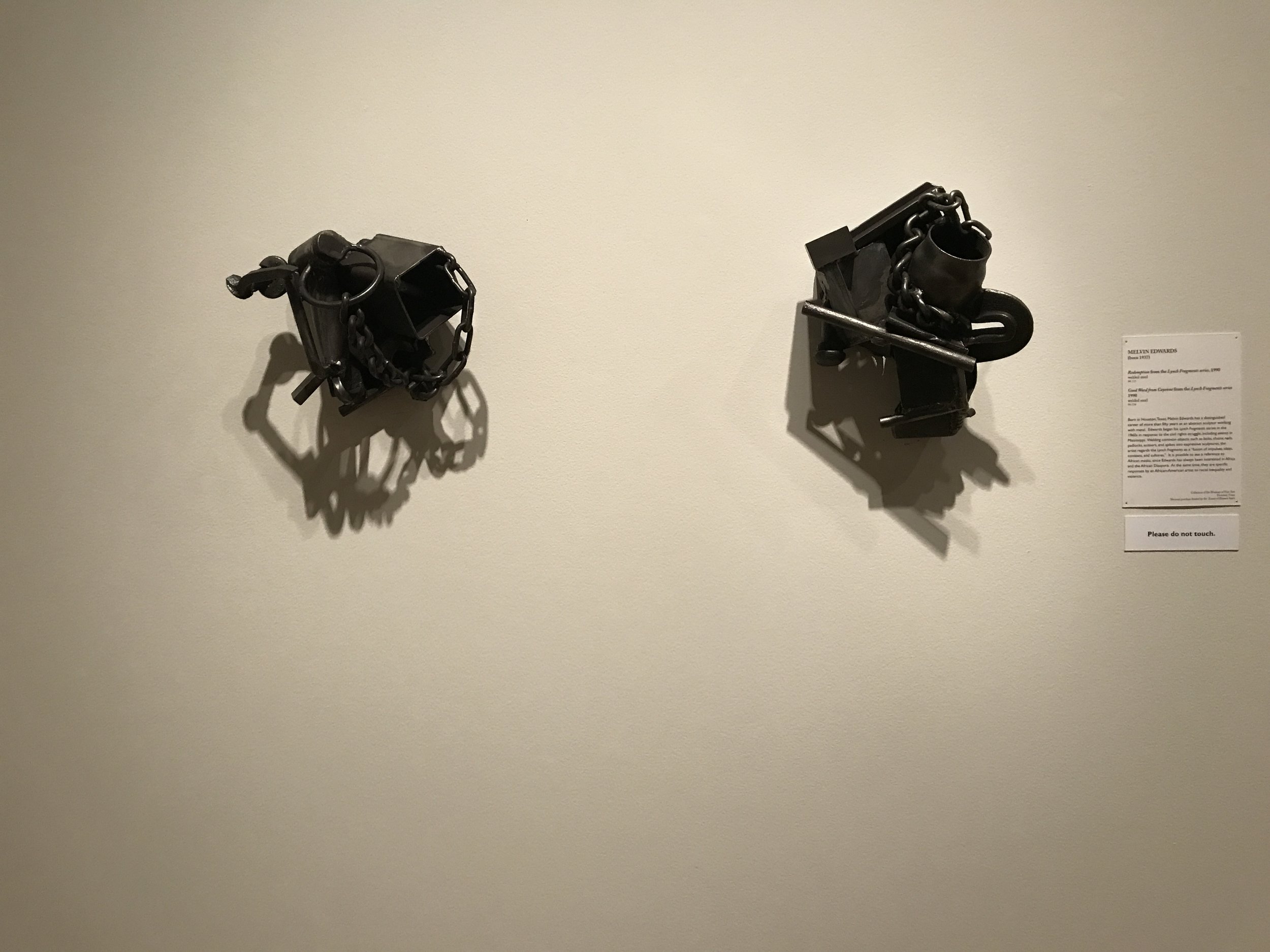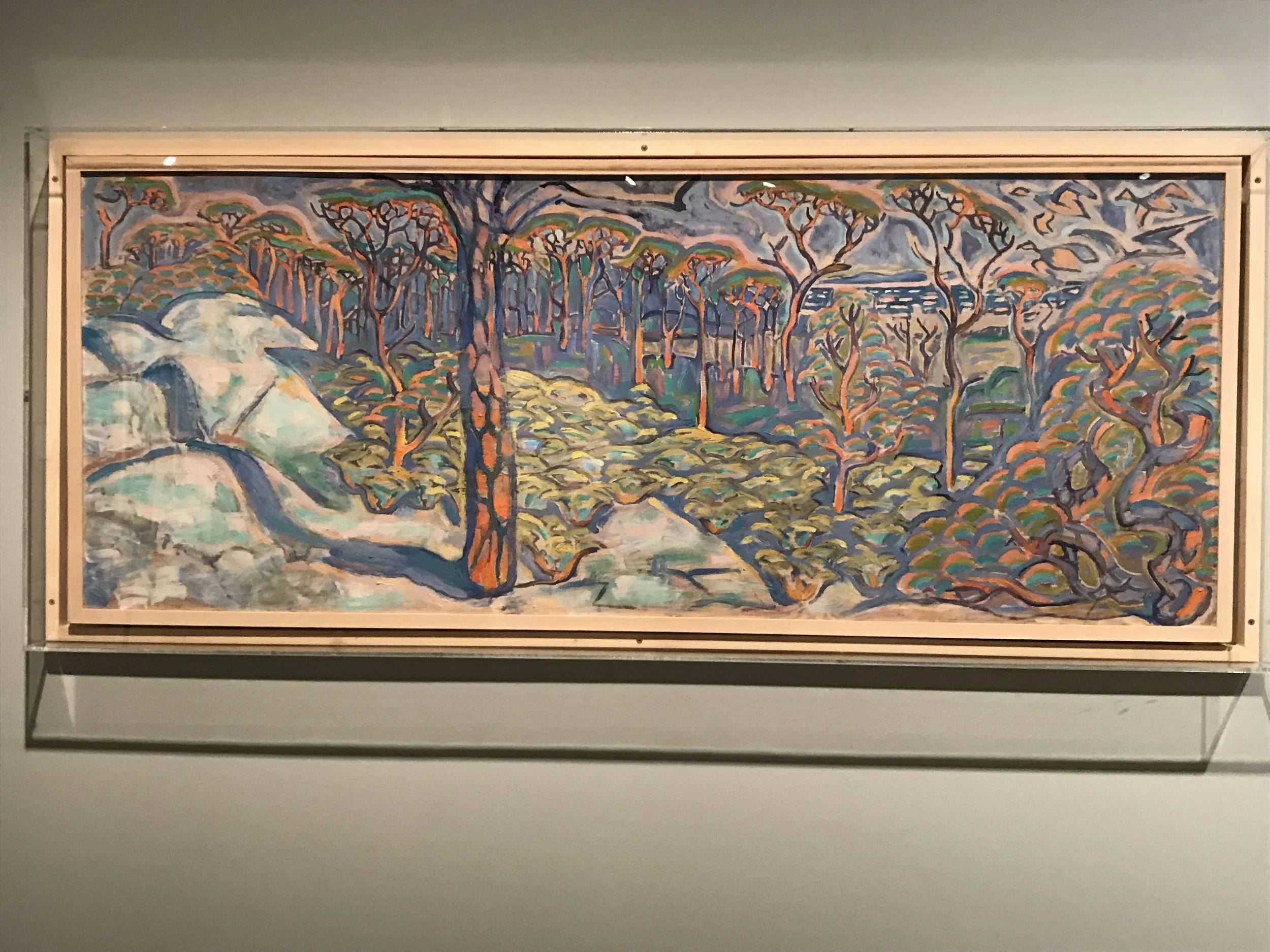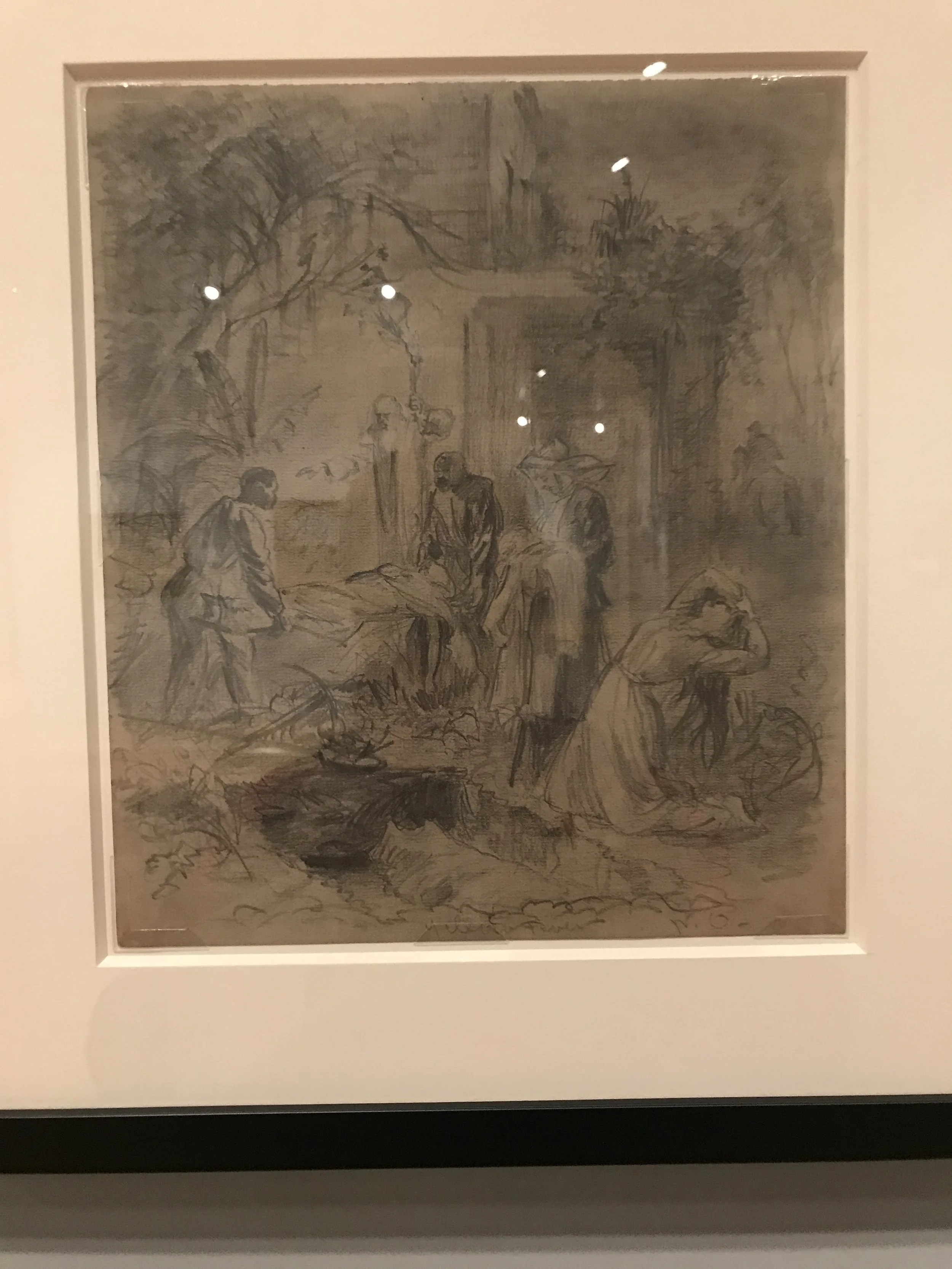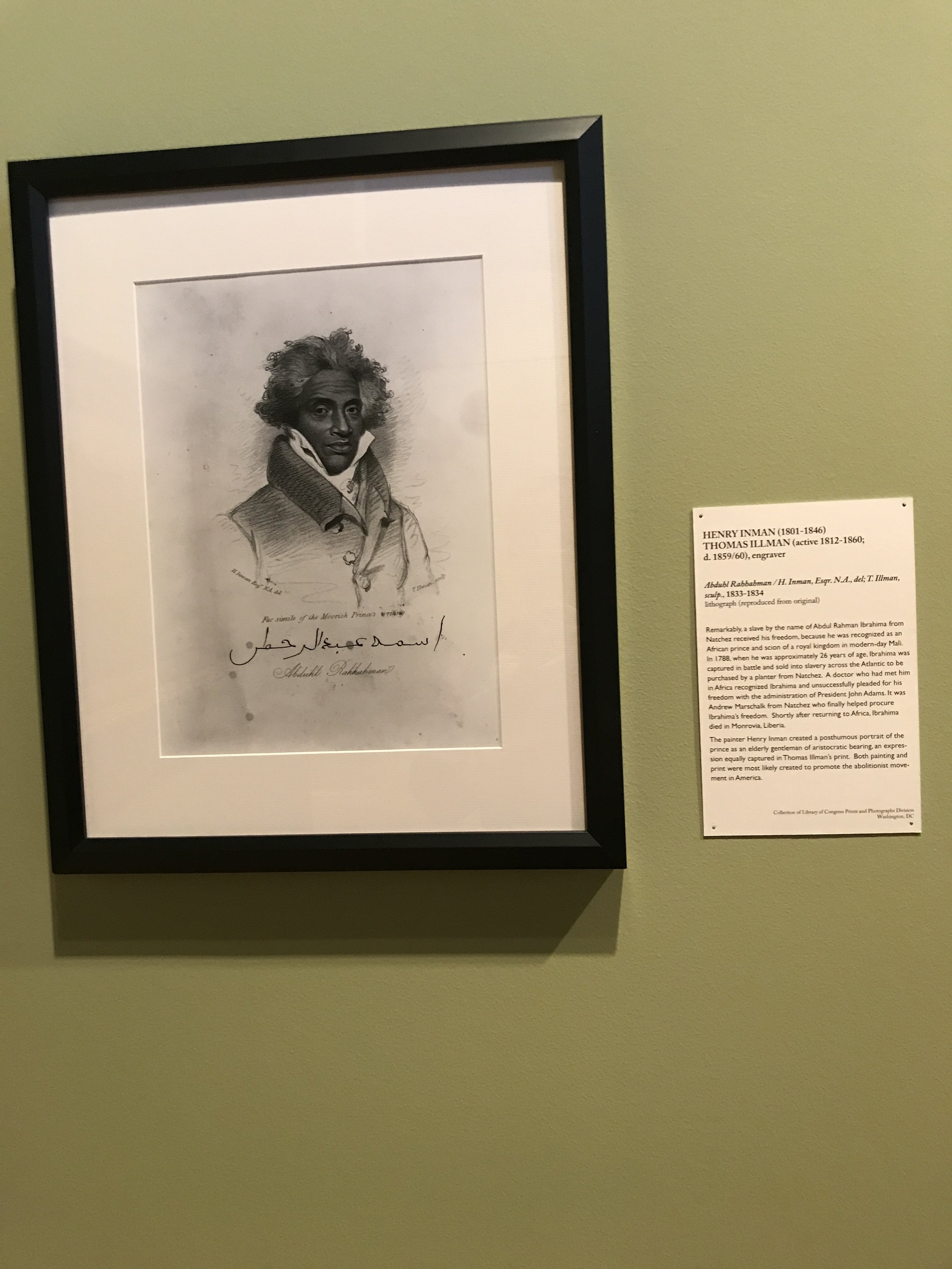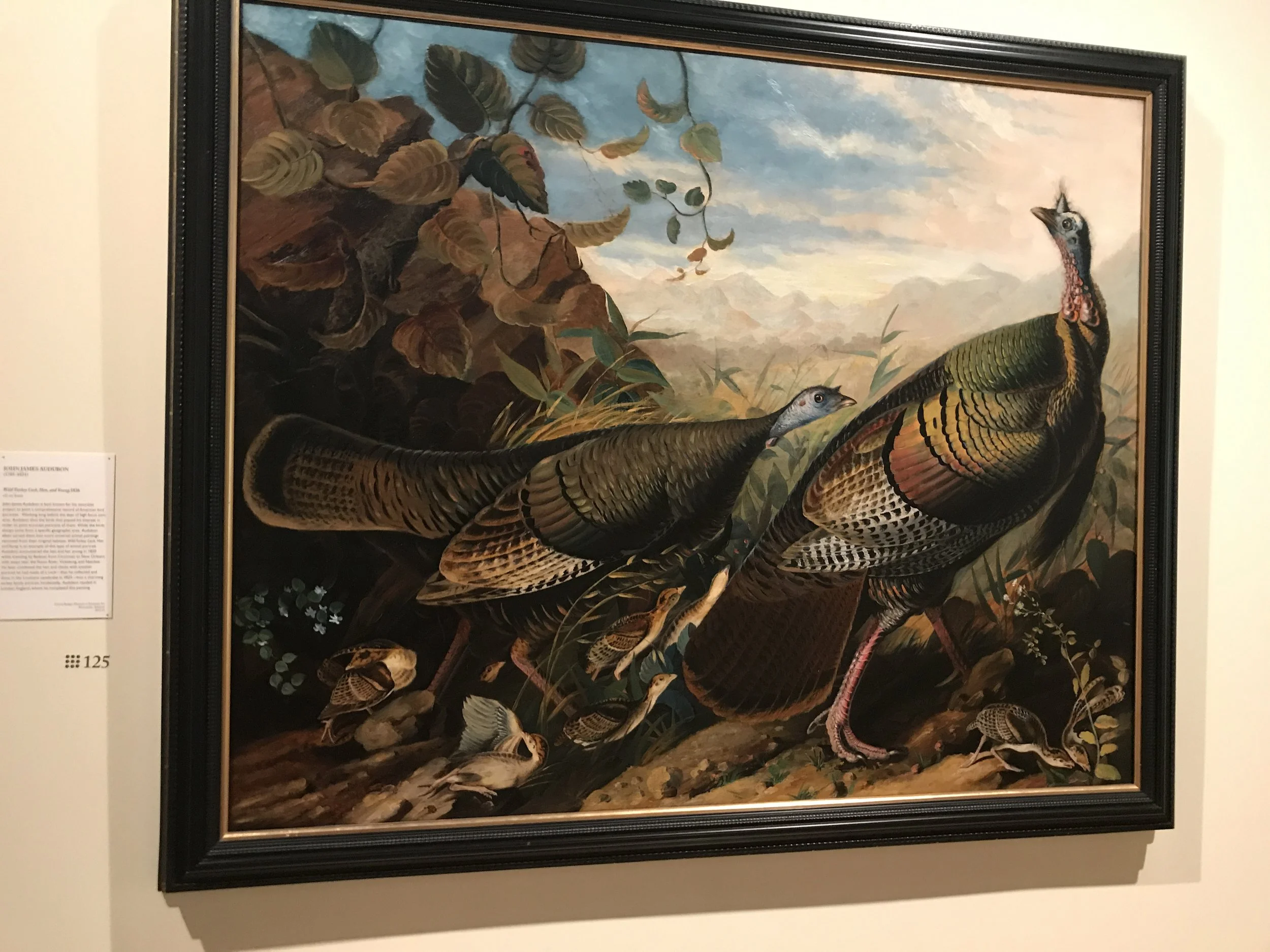MS Day 2 - Capitols, Cotton, and Cola Glazed Ribs
Today started with a trip to Cups Espresso Cafe which is famous for supposedly having the best coffee in Jackson. I got their house cold brew, and after that I was pretty much won over. It was some of the best pure coffee I've had so far. Plus the art on the tables was... a lot. I think they were going for a coffee version of the Kool-aid man, but his catch-phrase seems a lot less catchy (and a lot more confusing) than "Oh yeah!"
All coffee'd up, I went to the Old Mississippi State Capitol Museum, which my Air BnB host said was their favorite museum in the city.
The first thing that stands out about the old building is that it has been stunningly restored both inside and out. Big grand Greek styled pillars out front, huge dome covered in painted flowers when you walk in, the place is stunning. The building and all its flourishes were designed by an architect named William Nichols who also famously designed the Mississippi Governor's mansion and the Lyceum building at Ole Miss.
From 1839 to 1903, this building housed the governor, the senate, the house of reps, the supreme court, and other government offices for the state of Mississippi. The self-guided tour of the building started with some of these important government offices. First up was the office of the Keeper of the Capitol, which, contrary to what the name might suggest, is not a character from Lord of the Rings. Instead the keeper of the capitol was kind of the hidden engine that kept the government working, part janitor, part-librarian, and part-housekeeper. For all that work, they were granted the special privelage of being able to sleep in their office. The next office belonged to a much bigger name that probably did a whole lot less work, the governor. The office came with a statue of one of the historical governors at his desk. I think it was as cool as it was sort of creepy.
Next up came an exhibit on the building and the restoration of the Capitol itself. This was one of my favorite parts of the museum because there were a lot of fun anecdotes that went into the building process. Right off the bat, William Nichols wasn't the first architect brought in on the project but when he was given the case, he decided to completely tear down what was done before and start from scratch. He may have been just a tad bit anal, because he also went through not one, not two, but three different brick makers before he was satisfied. Unfortunately despite all the effort Nichols put into making even the smallest parts of the building perfect, the capitol eventually fell into disrepair until the local government and the city eventually raised the funds to fix 'er up. At the center of the exhibit was a big sculpture representing this period of decay. I really liked this, because at first it just looks a pile of random junk but when you read about, it becomes clear that the artist put every piece very intentionally in its final location. I alway like when art messes with your head a bit.
The next gallery was more of a general collection of artifacts representing life and politics in Jackson through history, These included civil war uniforms and weaponry, a parade float from an agricultural convention, and even something as as recent as an invitation to a Bill Clinton rally from his 1992 campaign. My favorite thing though was just a little plaque dedicated Dennis Murphee who made it into Ripley's Believe or Not for his political career. He ran for governor three times and lost every single time, but he still became governor twice because two of the times he was lieutenant governor the actual governor died in office. I guess that's one way to do it.
Next up came the house chambers, where several landmark laws were passed. I thought this was really interesting, because while the Old Capitol passed the decision to secede and it's fair share atrocious Jim Crow laws, it also passed some of the most progressive laws in the country at the time which I had no clue about. These include the first laws allowing married women to own property (in 1839! How insane is it that wasn't sooner anywhere in the country), establishing the first public college for women (it did specify it was for "White Girls" but sometimes progress happens in baby steps), the first land grant college for black students, and the first schools for Blind and Deaf students in the country. I think history always by convenience simplifies narratives, but I think it's fascinating that even at the heights of blatantly racist and sexist law-making there were still voices of dissent in the legislature trying to make sure everyone got good educations. regardless of race, sex, or ability. Of course the cynic in me would point out that separate colleges might be more motivated by maintaining segregation than providing opportunities but again baby step.
The next wing was the Mississippi Hall of fame. This was a series of really well done (in terms of artistic talent, not like charred) portraits of notable Mississippians with little explanations of their accomplishments. This was my favorite part of the museum, because it was just a big colorful celebration of human achievements in art, politics, education, and more. What could be better than that? My personal favorite portraits were : John Roy Lynch, who went from slavery to being the first African-American Speaker of the House in MS; Pushmataha, the leader of the Mississippi band of the Choctaw Indians, who fought with Andrew Jackson in the War of 1812 and then fought against him against Indian removal until his death; George Ohr, an innovative potter who also looked like an absolute insane person; novelist and short story-writer Eudora Welty, who had the most piercing blue eyes of any portrait; the women of the Ladies Memorial Association who developed Decoration Day a forerunner to Memorial Day and worked diligently to make sure fallen soldiers in the Civil War were returned to their home states; my main dude William Faulkner, very possibly the greatest American novelist of all time; Richard Wright, the author of Native Son and avid campaigner for Civil Rights; every First Lady of Mississippi; and Nellie and Lucy Somerville, the first mother and daughter pair in America to both serve on State legislatures.
The next room I saw was the house of the State Supreme Court. This featured more vaguely creepy, mostly cool statues of former judges and also some notable court cases that really paint a portrait of how insane things were during slavery times. One case involved an escaped slave who ran away from someone her owner loaned her to because he whipped her. The owner said the slave could return if the other guy agreed to not whip her or "whip her moderately". The other guy refused these terms, because that was clearly asking waaayy too much, and then sued the owner for breach of contract. The owner appealed it, and won thankfully but Jesus Christ what an awful time to be alive.
The last room was the senate quarters which also featured statues in very argumentative poses discussing various major laws with actors doing voice overs of their transcripts. Some of the transcripts included the Married Women's Property Laws and the decision to Secede and things got pretty heated. They even had an authentic senator's spittoon!
After the capitol building, I went to the Mississippi Museum of Art. Things started off on a good note with a sculpture garden outside the museum the museum featuring pillars with crabs on them, cute mosaics of frogs, and fountains. It was really serene and relaxing, and a good omen for the museum to come.
The museum was free to the public and entirely dedicated to one big exhibition called Picturing Mississippi celebrating the bicentennial of the state and bringing in over a 100 different artists either from Mississippi or doing work related to the state. It was a really impressive large scale enterprise and they made the really cool curatorial decision to mix and match contemporary and historical pieces together to show how similar themes have been explored then and now occasionally with pretty different representations. I really loved it.
The first two pieces in the exhibit were sort of strategically chosen as mission statements for the project. One of them was called Flying Geese by Hank Willis Thomas which used cut up archival photographs of African-Americans into a quilt like patterns. All in one work you get nods to early African and Native-american craft traditions, historic photographs with the spaces in between representing erasure of minority identity, and a style representative of more modern abstract art. It's a cool way of showing how the museum intends to blend the old and the new to look at history in new ways. The other piece was called Justice, Faith, Hope, and Peace by Joe Overstreet. The piece was painted in response to MLK's assassination, and uses abstract shapes that very intentionally asymmetrical to show the jarring confused reaction to such a loss. It's a cool way of looking at how artists reacted to big historic events in the moment, and also shows how abstract forms will fit just as much into this historical exhibit as more opaquely representational work even if it's less intuitive.
The works tended to be grouped along different historical or thematic through-lines. The first room was all about the earliest Mississippians and how different representations of Native Americans have changed over the years. Some early works from the first Europeans to make contact were very anthropological and tried to document them like an exotic species. Other early works show them as very primitive in need of saving by missionaries or totally at one with nature. Later works highly romanticize them, and one of the more recent work by the late great Benny Andrews attempts to capture the cruelty and the bravery exhibited during the Trail of Tears. It is interesting that so many of the works were actually by Native American artists so taken all at once it really shows a complicated history of how different groups chose to represent Native Americans depending on how the outside world viewed them at each point when the paintings were made as opposed to anything to something like an unbiased historical account. Tellingly the only work from an actual Native American artist (which I unfortunately didn't get a picture of) was a contemporary piece featuring a punching bag that had been covered with traditional bead patterns. In that way the artist uses his own cultural heritage to reclaim what he sees as the unfortunate historical narrative of his people being other cultures' punching bag.
Continuing with some of the more heavy historical themes was a series about slavery. These included a work by a British artist named Eyre Crowe who was one of the earliest artists to represent the slave trade as the truly horrible thing it was. Other highlights for me were a piece by one of my favorite contemporary artists Kara Walker depicting enslaved people in shackles in the form of a pop up children's book to show how children are taught history but a more toned down version of some of the crueler aspects, and a painting by George Moreland that shows a slave standing up to a slave trader even though he's outnumbered and facing serious threats. These were really powerful.
The next section was about the civil war and had some really fascinating historical pieces, including annotated sketches by Alfred R. Waud, a press correspondent during the war, that display a shocking number of techniques similar to modern day comics way ahead of the curve of graphic storytelling; and actual early gelatin print photographs of bodies on the battlefield that makes the brutal realities of the war shockingly real. I always forget how far photography had come along at that point, so I never expect to see actual footage from that time in history.
Next up came something a little more light hearted. It was a little interactive alcove featuring a painting called the Jolly Flatboatmen showing people having a grand old adventure on the ol' Muddy. Across from the paintings were props and costumes for you to recreate the painting with friends (and presumably children). I couldn't resist, and I might not be quite as jolly as the guys in the painting but I am very ready to go on a log raft and have adventures that serve as a metaphor for the entire American experience. Plus I think three cornered hats might be my look.
On the flipside of joyous approaches to the Mississippi River were a few works by an artist named John Stuert Curry about the great flood of 1927, which (shockingly) disproportionately affected poor African-American communities. His paintings and drawings capture such affecting portrayals of human emotions across the entire spectrum from the pits of despair to the most faithful optimism. He really makes you feel like you are right there with these people during this terrible time.
Almost hitting on a trend, the tougher theme of the flood was immediately followed up by more lighthearted works capturing different approaches to representing Southern landscapes, both manmade and au natural. I loved the variety of artistic techniques across the same theme. My personal highlights were: a contemporary piece by Randy Hayes which features a grid of photographs of different run down southern houses painted to form the image of a grand plantation mansion; a vibrant impressionistic piece by Bob Thompson called Homage to Nina Simone that captures more of the essence and universality of Ms. Simone and the lands she loved but hoped to change than a more straightforward representation might; a piece by an artist whose name I forgot to write down finding the beauty even in a back alley dice game; a piece by one of my favorites from the museum of art in Augusta, Georgia called Evening Meal by John McCrady which shows a cross section of a small one room cabin as a man naps in his chair after work while his wife makes dinner; a painting by Hale Woodruff called Mississippi Wilderness which shows a lone, Black girl walking through a jagged and harsh wilderness which couldn't possibly be a metaphor for any social things going on at the time; and a super surrealist painting called Road to Shubuta by Noah Saterstrom which uses a lovely mismatch of imagery and colors to capture a road trip through one of the most notorious lynching sites in Mississippi. I like that all these works together create a nice portrait of the mess of contradictions that arise in any place with enough history, a mix of the grand and mundane, the wonderful and the horrible, and the beautiful and ugly that are a part of the state and the nation's natural and social landscape.
After these paintings was a collection of pottery by Mississippi Hall of Famer George Ohr. He is credited as being one of the first people to bring the abstract expressionist movement into the realm of 3-dimensional arts. Much like two dimensional abstract expressionism, I don't fully understand what it's going for but I do think it's pretty cool to look at.
Bringing things back to a more literal realm was a series of different photographs capturing various moments in Mississippi's history in beautiful black and white. My favorites from the photos were Bob Dylan playing guitar for the Student Nonviolent Coordination Committee; Freedom Riders with armed guards following their buses; William Faulkner just hanging out with some puppies; a young John Lewis looking like a freaking bad ass as he gets arrested for some civil rights protesting; and two different photos of very young children looking like real goddamned world weary adults.
Probably my three favorite pieces from the entire exhibit thus far were a piece by Ruth Miller called Flower which looks like a pretty decent painting but becomes almost unreally impressive when you realize that it is entirely made out of embroidered yarn; a piece by William Dunlap called Last Mississippi Painting which uses a totally irregular frame to jarringly juxtapose seemingly all of Mississippi history in one big painting; and lastly a really stunning print by Norman Rockwell called Southern Justice in response to the murder of three Civil Rights activists capturing the righteous anger of the Saturday Evening Post's golden boy with much more violent imagery than I'd ever seen from him.
The climax of the exhibit was a massive full room installation by Thomas Sayre called White Gold which combines gigantic paintings of cotton fields with intentionally heightened uses of black and white, plaster casts of tracks from cottons fields, and more abstract renderings of barn doors. The installation is intended to create an immersive experiences that probes the South's complicated history with cotton, at one time its greatest source of both economic prosperity and human cruelty. I don't think my silly little photos can really capture how cool it was standing in that room and getting the feeling of eerie dreamlike cotton fields stretching out forever in front of you.
One of the coolest supplementary things the museum did for the White Gold installation was to include a reading and listening room with books about the history of cotton industry and two iPads with different themed playlists made specifically for the museum, one by an ethnomusicologist capturing early blues, soul, and rock references to cotton fields and the other by a local DJ tracing the lingering effects of cotton plantation work and slavery in more modern music ranging from Gil Scott Heron to Kanye West. I thought it was a really cool way to get guests to engage even deeper with the art on display, and while everything had a deeper message some of the songs on both playlists were total bangers.
Walking out of the exhibit I saw two last little exhibits. One was a series of four incredible murals by Mildred Nungester Wolfe capturing FDR's four freedoms from one of his most famous speeches with highly dynamic and stylized figures and back drops.
And the last little gallery I saw before heading out was all the Pre-Columbian art which actually mostly came from Peru so it didn't totally fit in with the larger Picturing Mississippi exhibition, but I guess if these cultures are some of the earliest documented by man they're probably connected to Mississippians somewhere down the line.
At this point, I was pretty darn hungry because I hadn't expected to get as sucked into either museum as I ended up getting so I set out to grab a late lunch/early dinner/dunch. On the way to my car, I noticed that the planetarium is literally suspended over the street and I immediately regretted not finding the time to go there because that is freakin' awesome.
For my food, I went to probably the most recommended place to me in Jackson, the Pig and Pint. As the name suggests, they specialize in pork and beer and boy did they not disappoint on either front. I figured since this was my big meal of the day I'd splurge a little and go for the rib plate with beans, toast, and mac'n'cheese. The ribs were massive and doused in a special BBQ and Pepsi cola based glaze that sounds kinda weird but made for some of the most finger licking good ribs I've had yet. The Pepsi fave the more savory barbecue sauce a cut of sweetness and cola bite that worked way better than I would have imagined. You also can't really tell from the picture but they were some of the biggest pork ribs I've seen so far and it was more than enough food to fill in for two or three meals. Good god was it good. To wash it down, I got the Pub Ale from Lucky Town Brewing which despite it's decidedly bland name was a really solid British style bitter ale with a nice malty body and a good easy drinkin' flavor profile.
To not pass out into a food coma, I decided to go to local chain, King of Pops, for some coffee. While their specialty is definitely their homemade popsicles, they also end up consistently getting ranked one of the best coffee places in Jackson and they made for a nice play to go and get some writing done. Once I got a nice caffeine buzz and made it to a point where I was happy with my writing, I finally caved and got a popsicle dipped in beer because who can resist when you see that on the menu. Because I had never had a popsicle beer float before, I asked the cashier for her advice and she suggested a cheesecake popsicle in a vanilla bean stout, and dang if she didn't nail it. The creaminess of the popsicle thickened and brought out the vanilla flavors in the beer and the beer melted and mellowed the cheesecake flavors in the popsicle. It was a beautiful symbiotic relationship.
After that I checked in at my Air BnB before my open mic. Normally, I check in after shows so I don't always get to meet the people I stay with, but this time I did and I was really glad for it. They were a really nice family with two young kids who really cracked me up. The daughter couldn't wait to show me how good she was at using her dad's segway, and the son told me all about their genuinely interesting new foray into making craft soaps. It was super endearing, and the parents were also incredibly nice and funny sharing some jokes and taking a real interest in my travels and my stories. It was a real nice connection to make.
Unfortunately the open mic didn't quite live up to my sleeping arrangements. This was kinda my fault for not doing better research, but it turned out to be much more of a music open mic at a place called Fenian's Pub. The host said it would be cool for me to do standup, but it defintely wasn't the best venue for it. That being said, it was really good bar with a cozy feel and a huge beer selection, it's just that it was a crowd that came to eat, drink, and tune out while listening to music as opposed to have to invest in hearing jokes. I was the only comic, but I was given as much time as the musicians. I think if I had just ended after five minutes I would have done okay, but I tried to fill out the full ten and it was a losing battle trying to keep the attention spans focused on me, and probably not a battle that was really worth fighting. I figured it might salvage my set, and be nicer for the audience if I tried out doing crowd work, which to be fair I am not actually very good at so I don't know what I was thinking. I asked the table with the most people if there was anything they wanted me to talk about, and god bless their honesty they replied "Really, we're just trying to eat." Much less subtle was the person at the table behind them who just yelled "Get off the stage, motherfucker!" I figured I might as well oblige.
While the set was less than great, I did end up having a surprisingly nice conversation with a traveling businessman in the bar about Dave Chappelle and tax cuts. We both agreed that Dave Chappelle was one of the best ever, but we disagreed a bit on tax cuts. He raised the pretty fair point that I hadn't heard before that tax cuts for him as a small businessman would let him hire more employees and pay them better. He said that tax cuts for the wealthy with the stipulation that they actually used them to benefit employees could be a really good thing. At this point, I stumbled into a very good phrase to use when you are enjoying a conversation with someone who potentially has different political views as you and it is "I could be wrong, but..." I stumbled into this because I legitimately had no clue if the thing I was going to say next was correct, but I think just admitting that uncertainty does a lot to diffuse the standoffishness that can come with really any disagreements, but particularly political ones. I said that while I might be wrong, my understanding was the current tax cuts on the wealthy came with less regulations not more as to what that money would go to, and this led to us both agreeing that probably wasn't the best possible scenario. Then again I could be wrong.
Favorite Random Sightings: Chainsaws and Casserole; Mister Carwash; Rim Time
Regional Observations; One of the comedians from Mobile warned me that the roads in Jackson were so poor, he referred to the city as Jackganistan. I think that might have been a slight overstatement, but they are by far the most be-potholed roads I've seen so far.
Albums Listened To: The Ooz by King Krule (a weird mix of jazz, hip hop, and punk with very very British vocals); Open Season by the Stubborn All-Stars (probably the finest 90s ska supergroup which isn't to say there was a whole lot of competition)
People's Favorite Jokes:
A blind man walks into a bar and starts spinning a dog over his head wildly. The bartender says. "Whoah what are you doing?" and the blind guy says, "Just looking around."
A blonde goes to the laundromat and hands in a dress to be washed. The cashier says "Come again!" and she says, "No, it's just mayonnaise"
Songs of the Day:
It's weird and long but the instrumental bridge between the two songs is particularly cool!
90s MTV was truly an insane hellscape, but this song is one of my favorites

